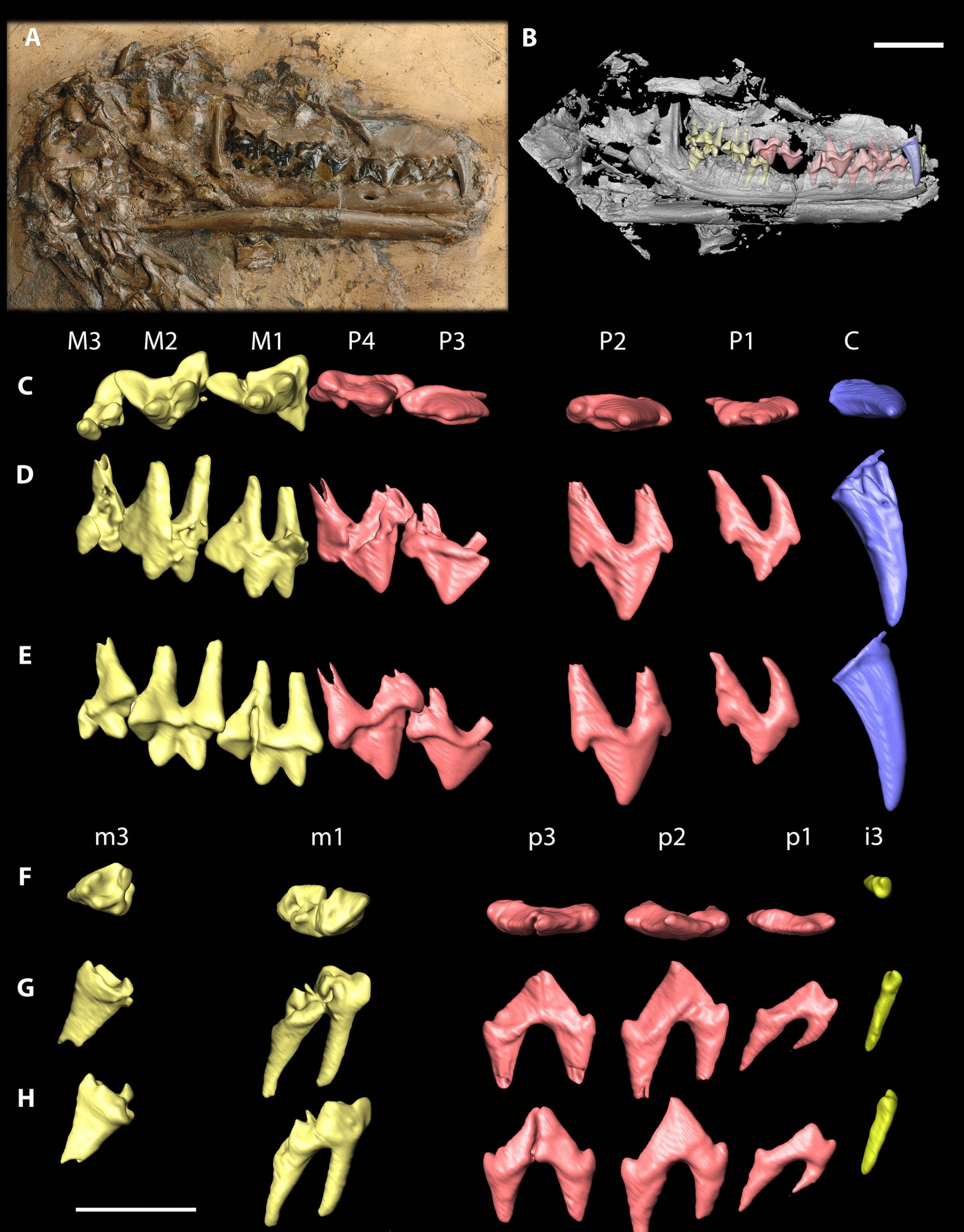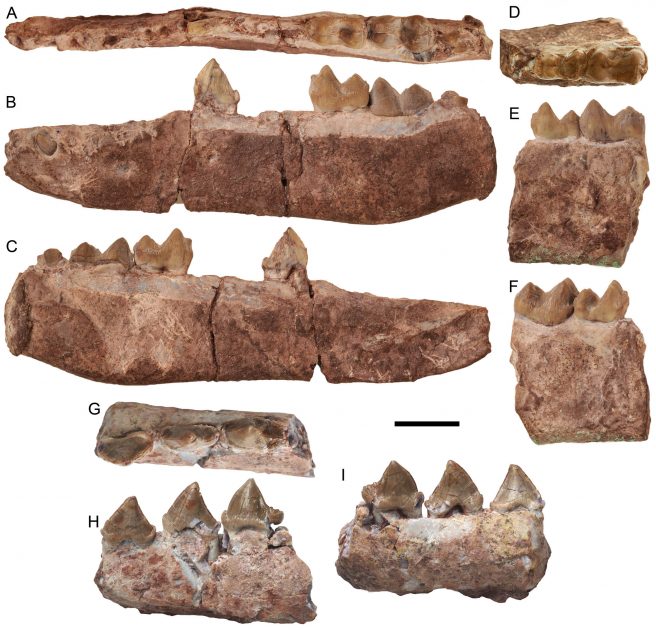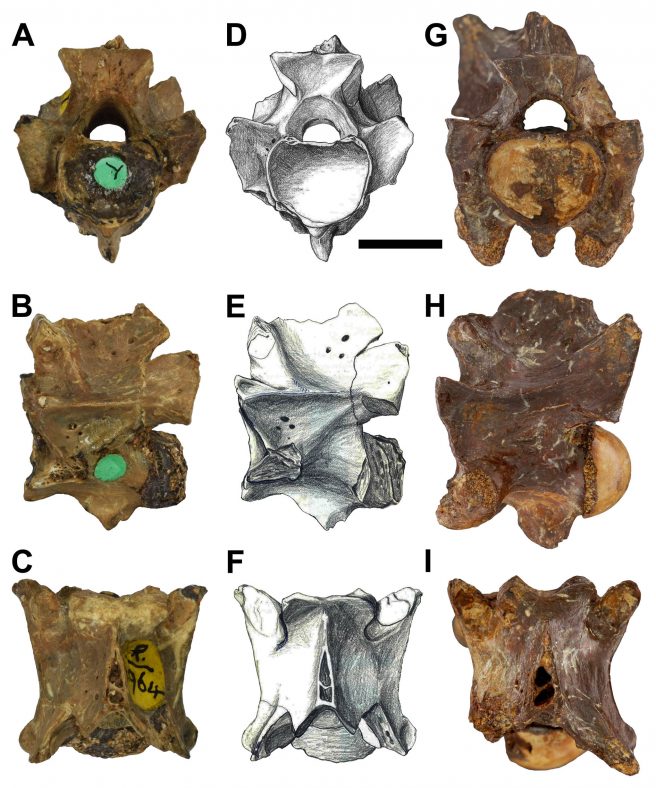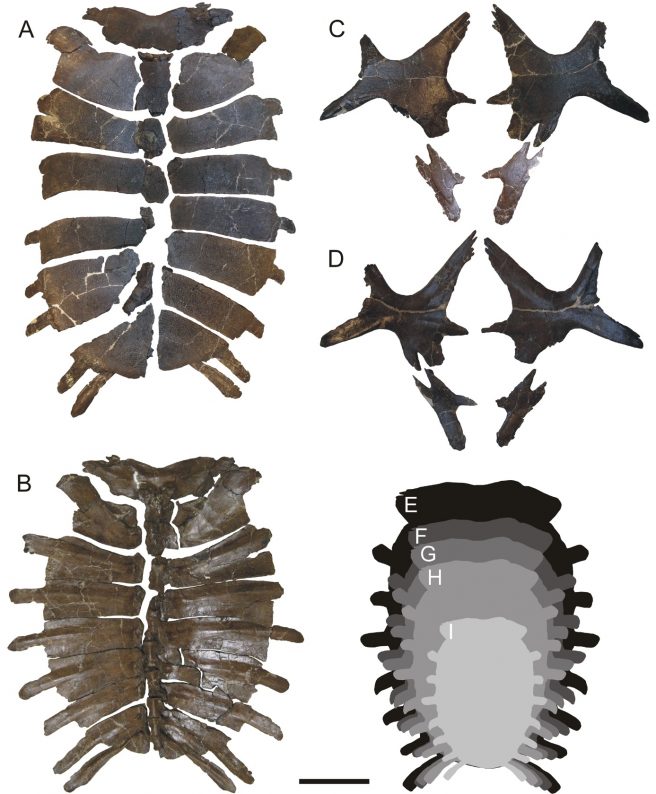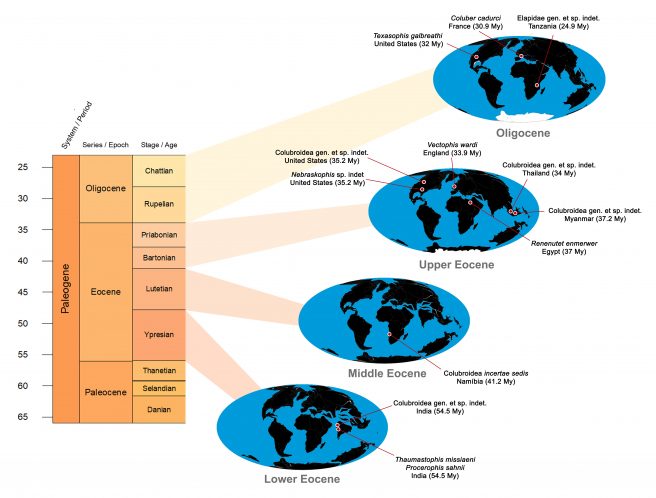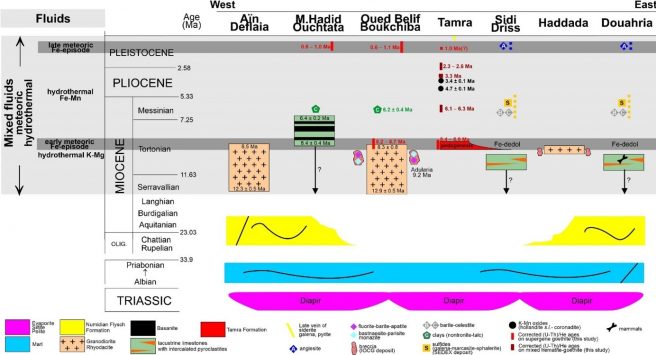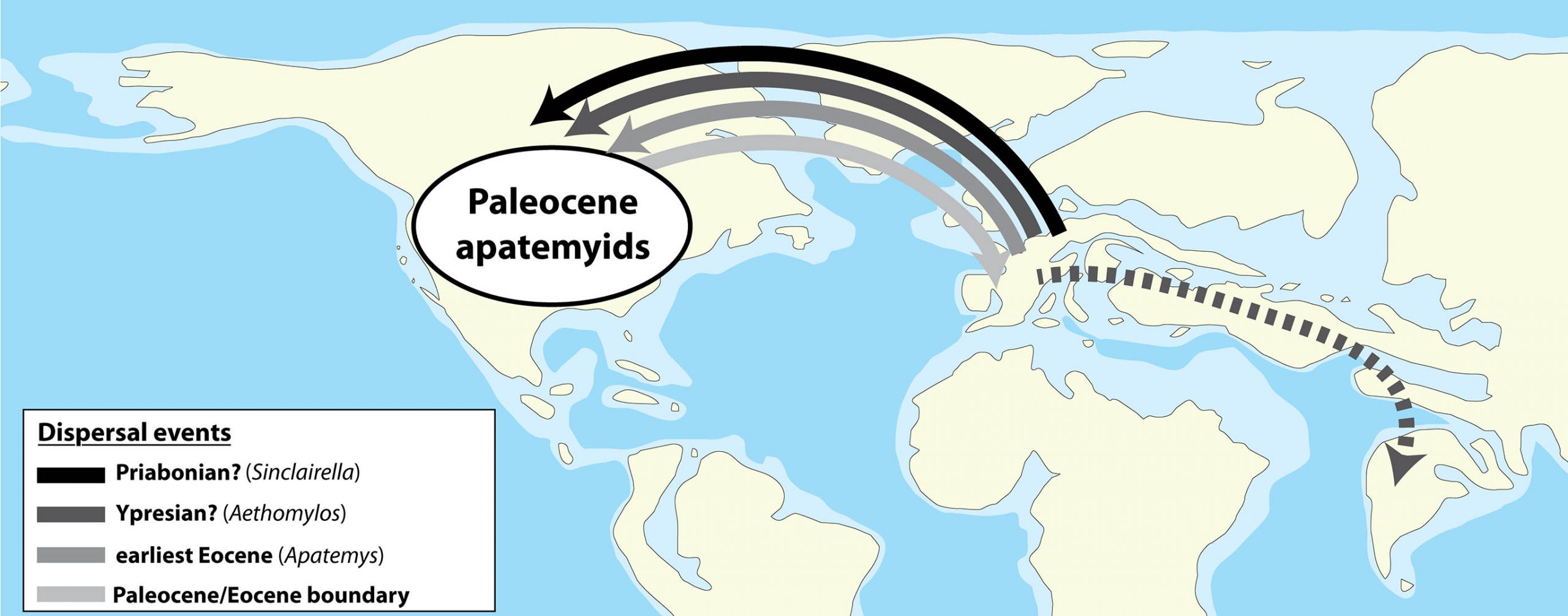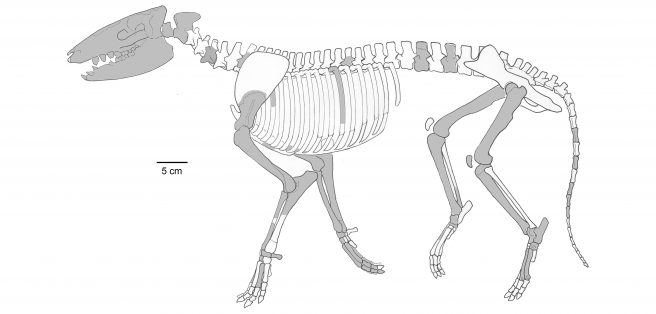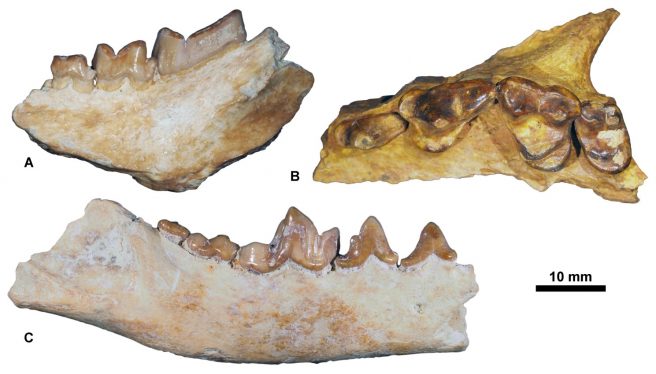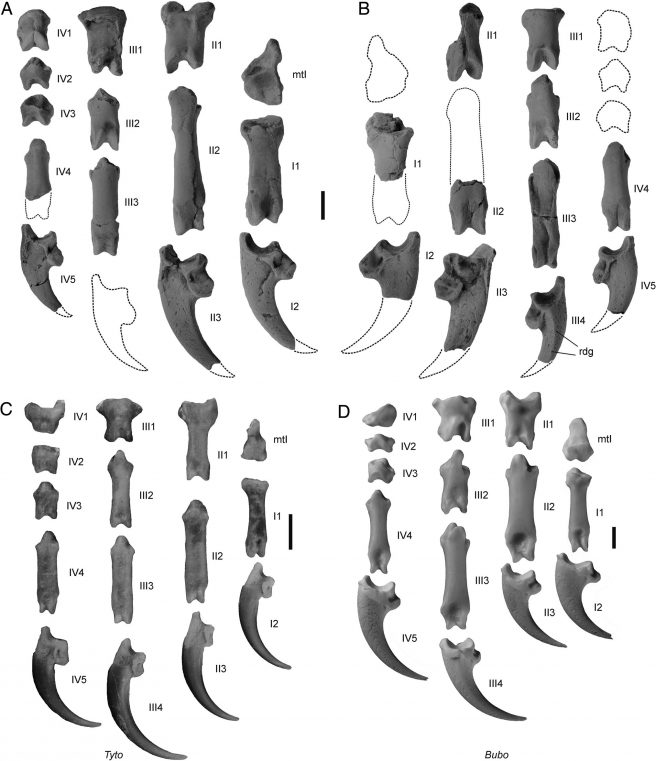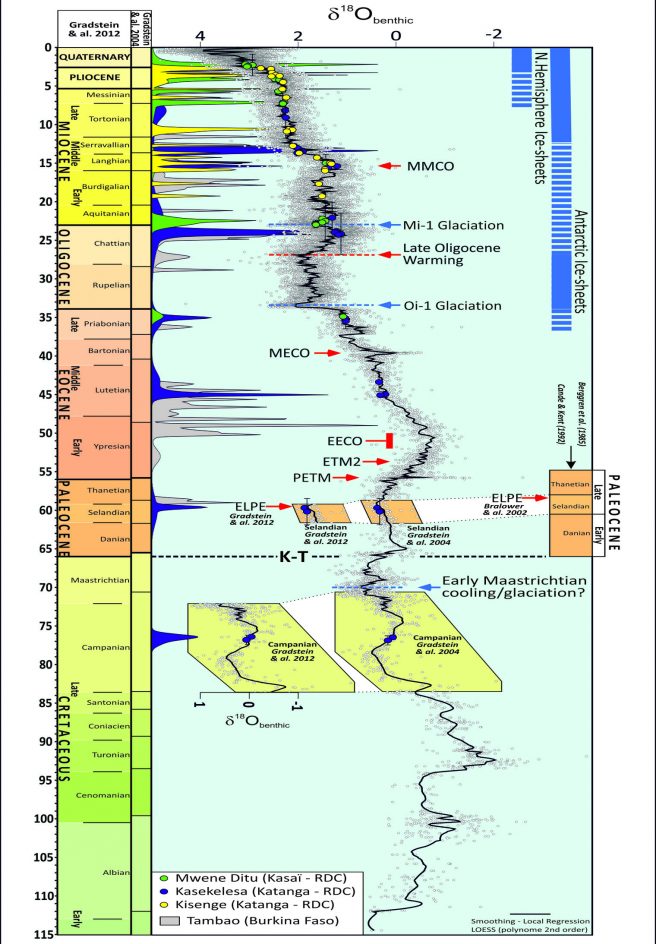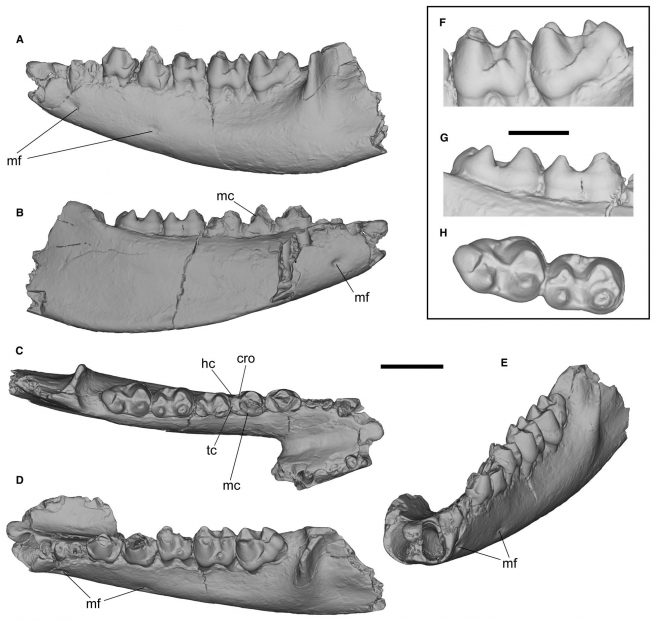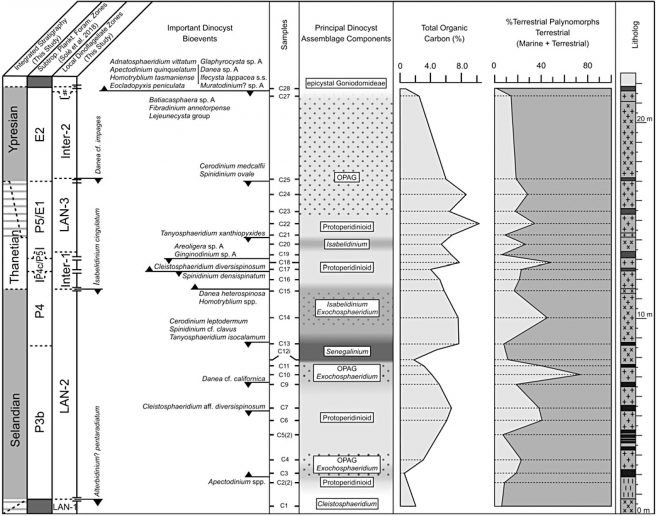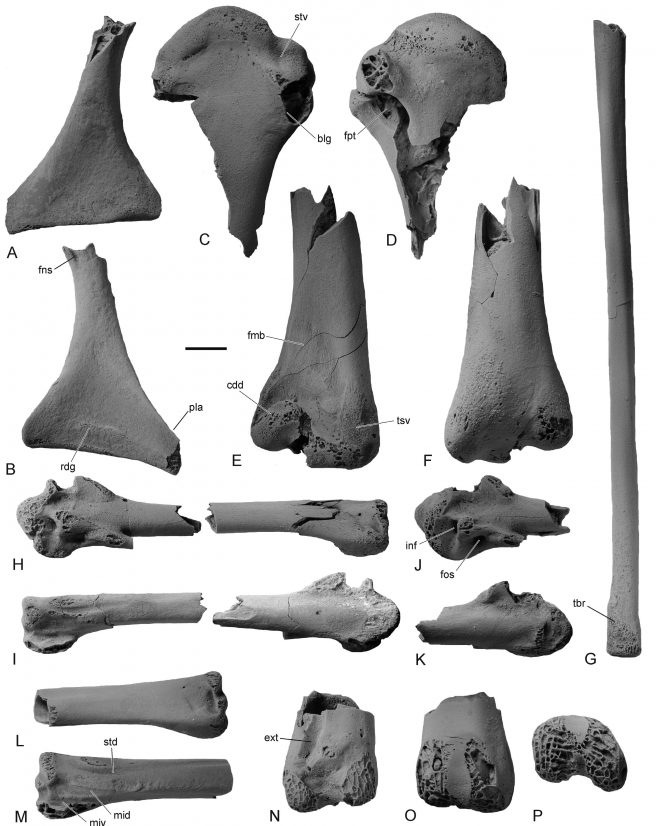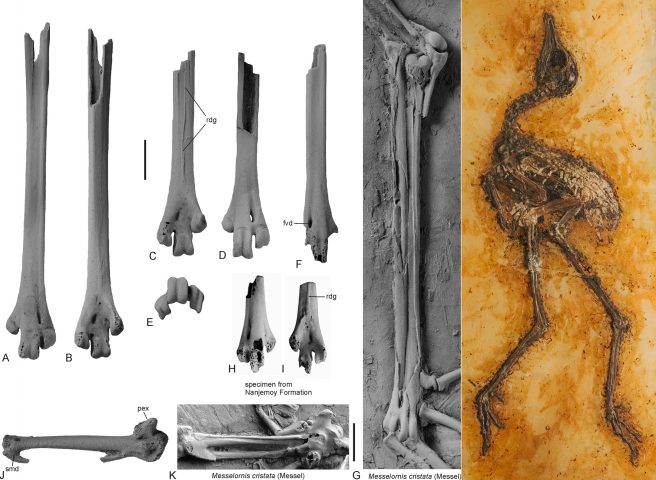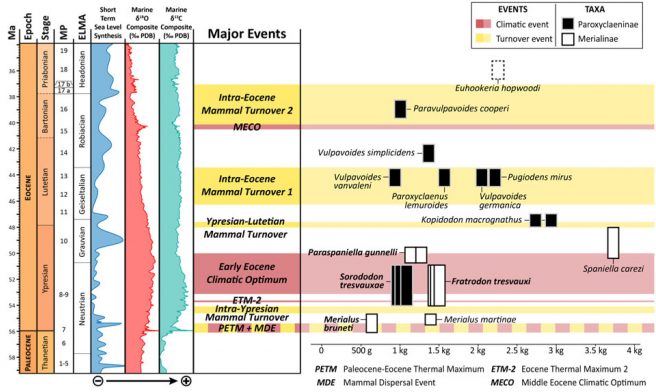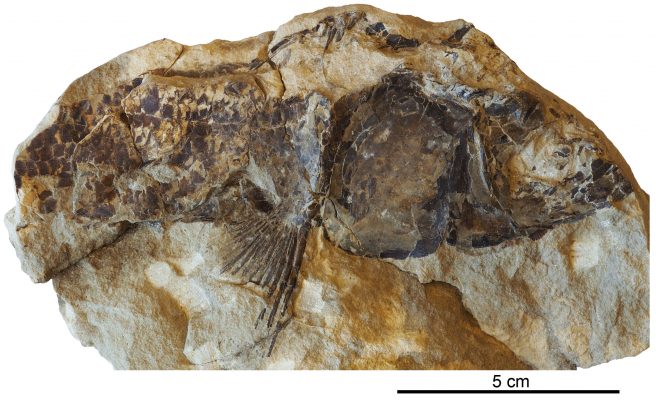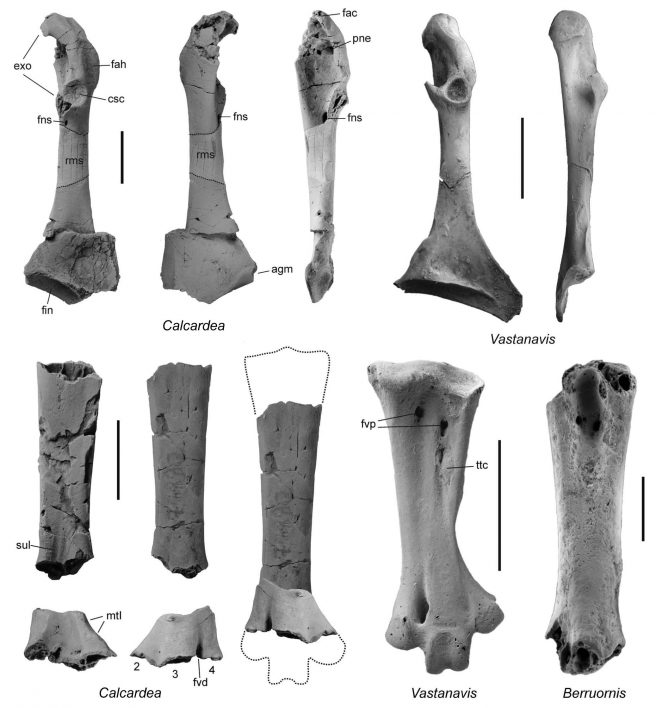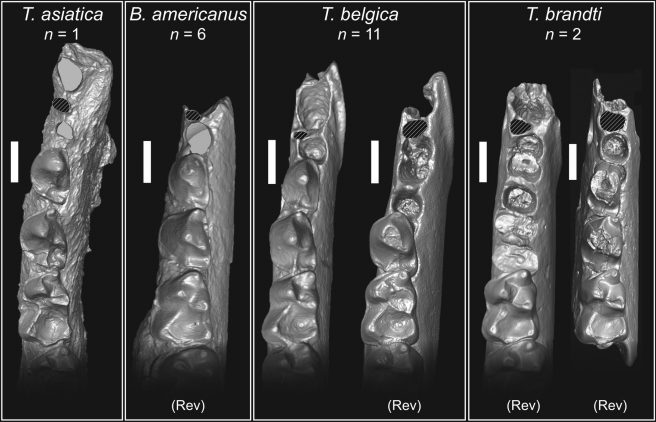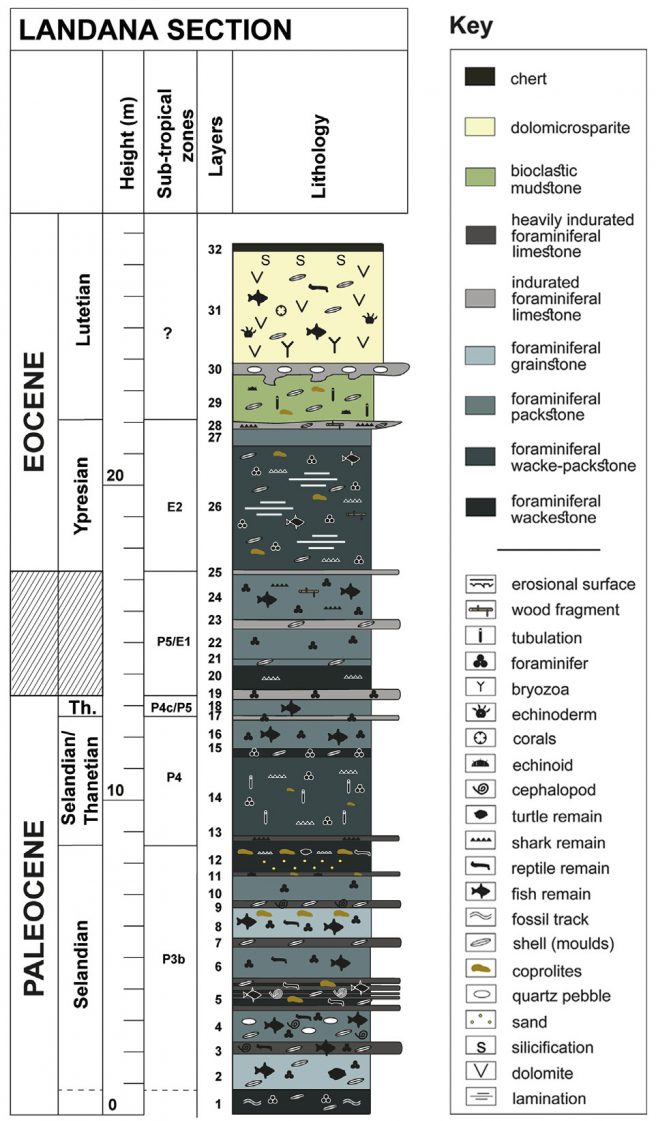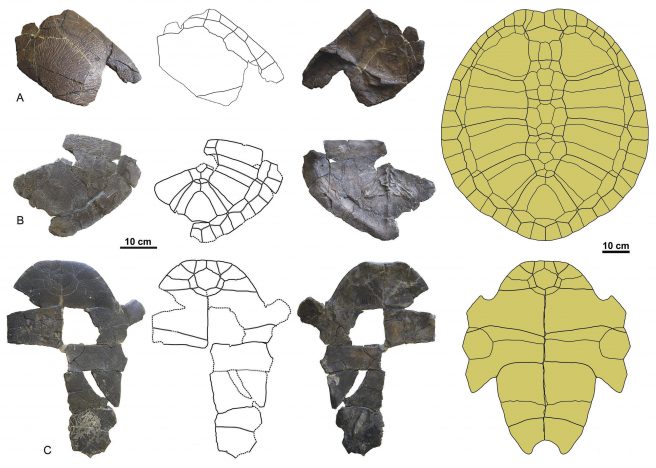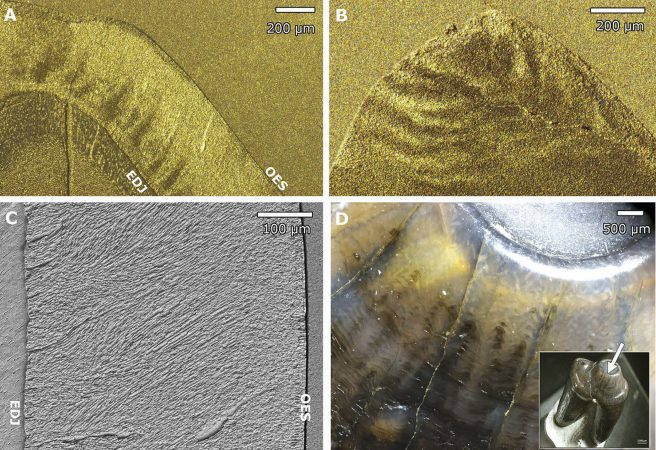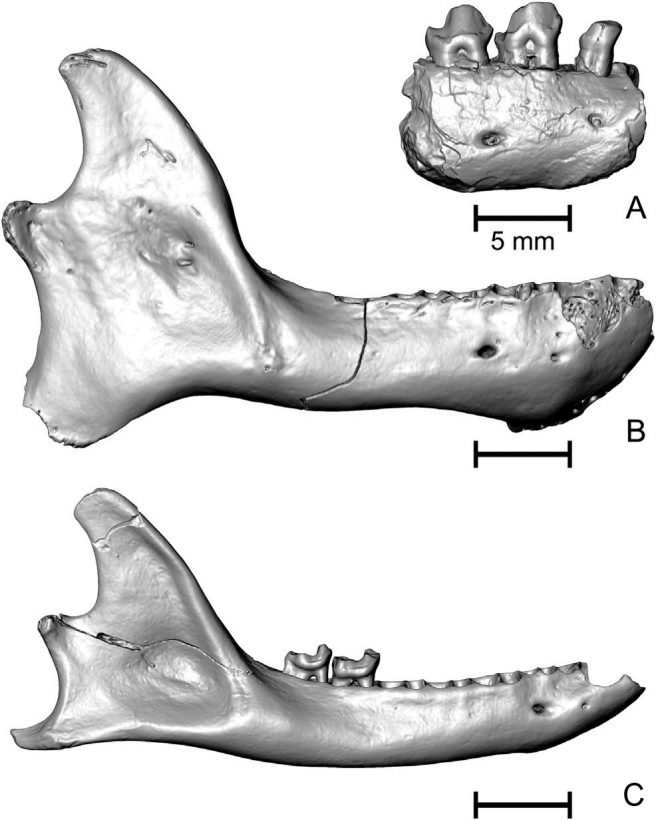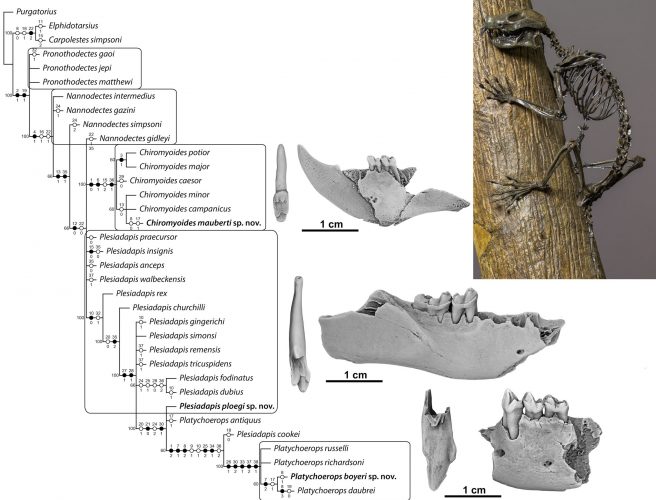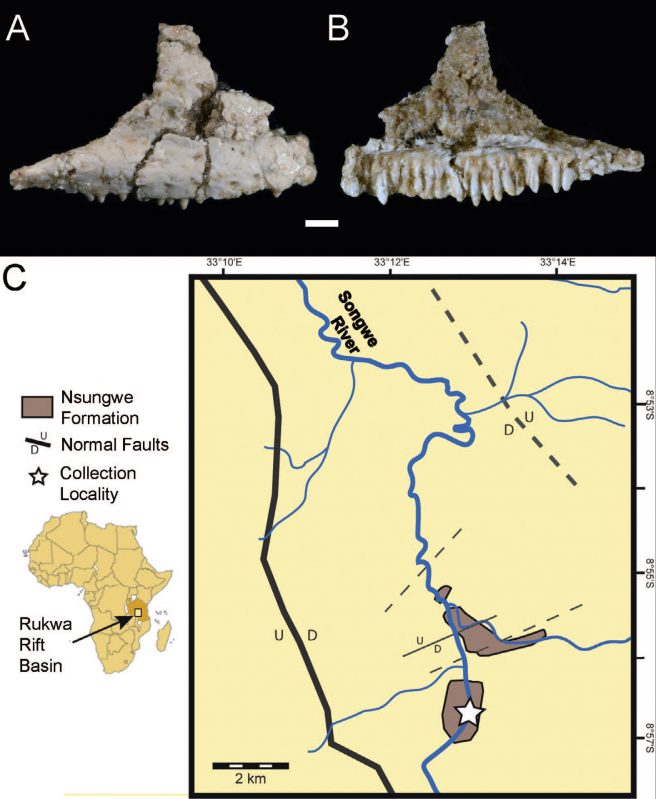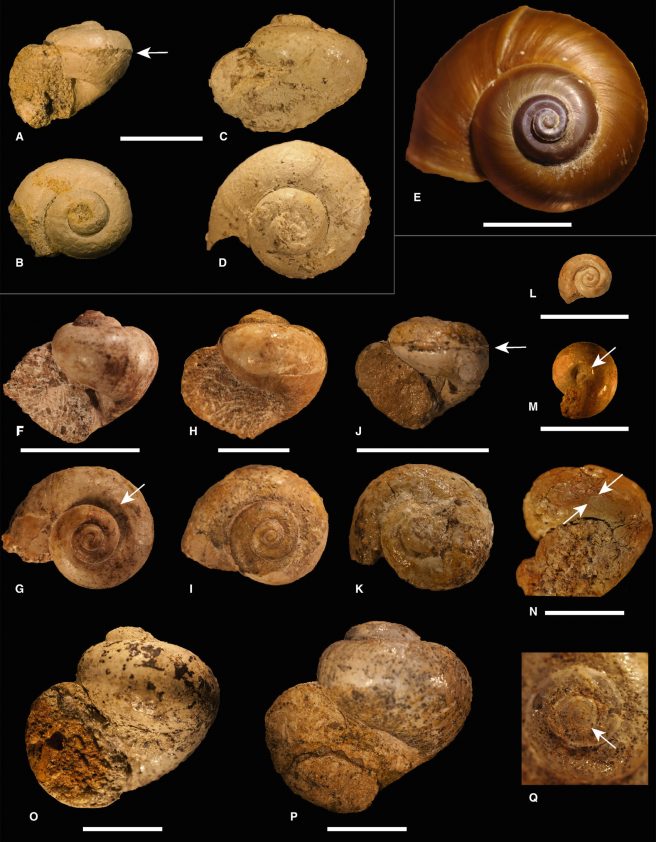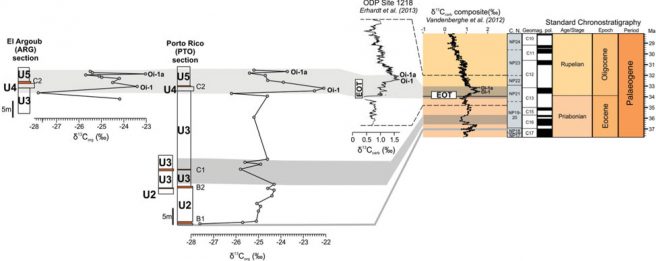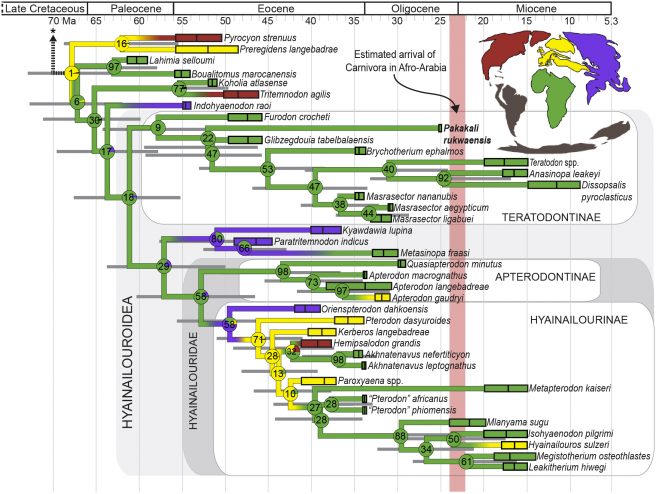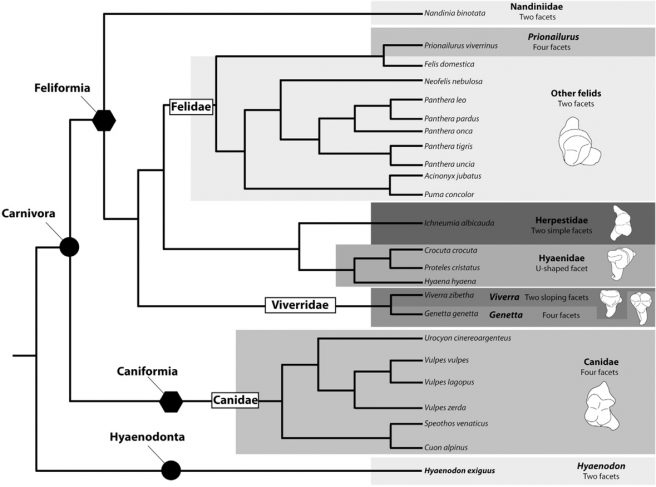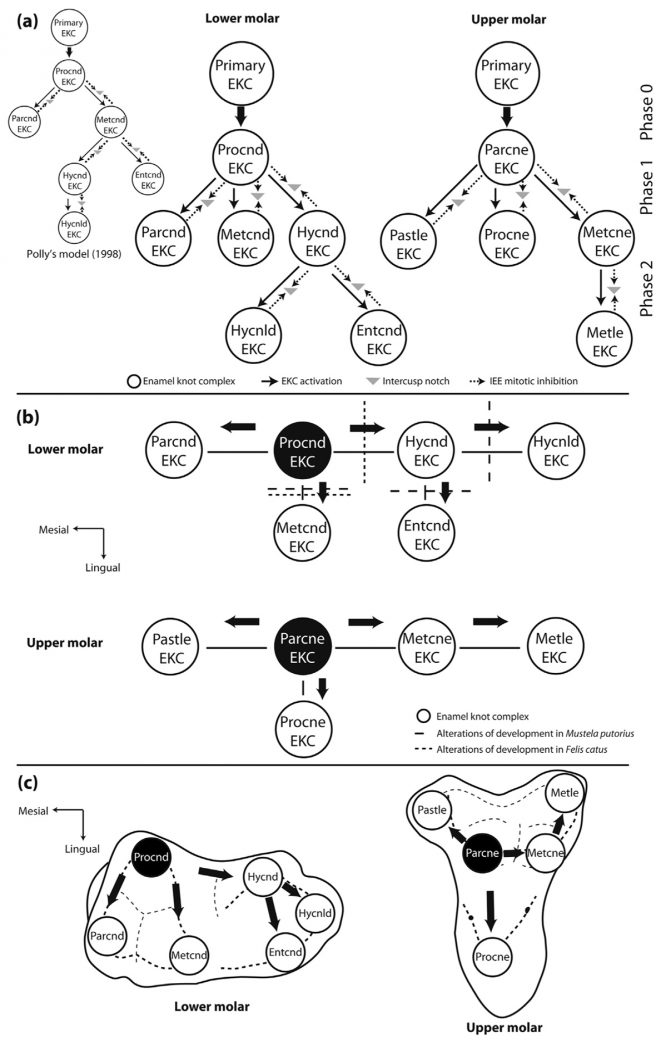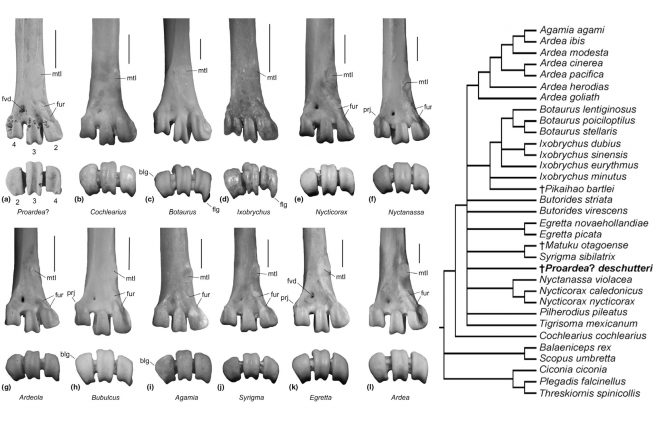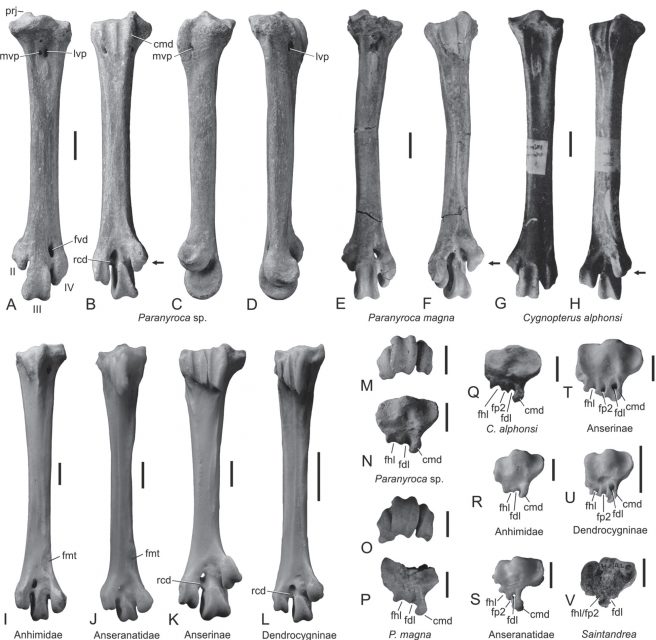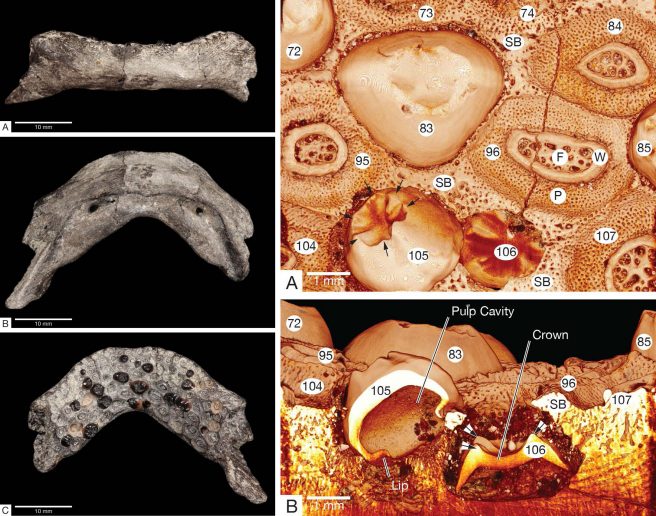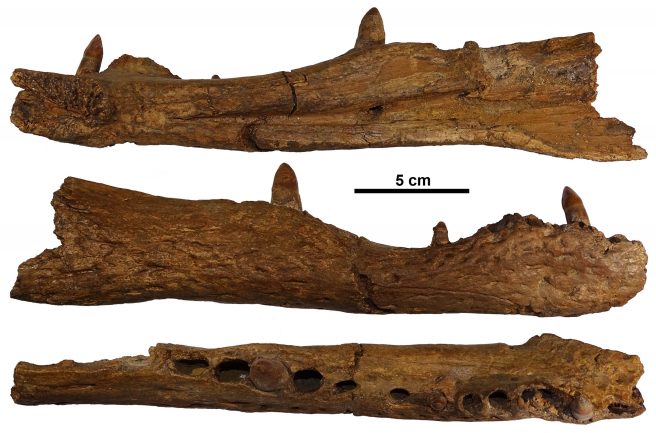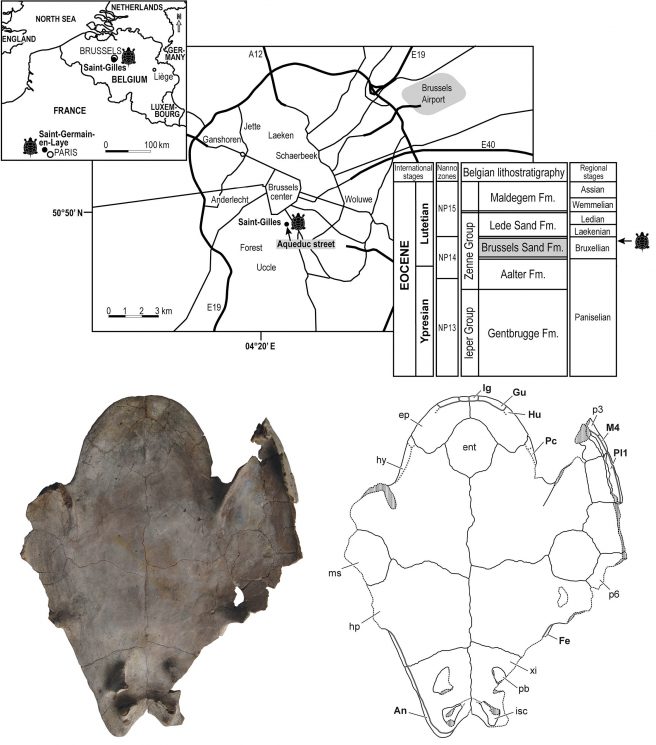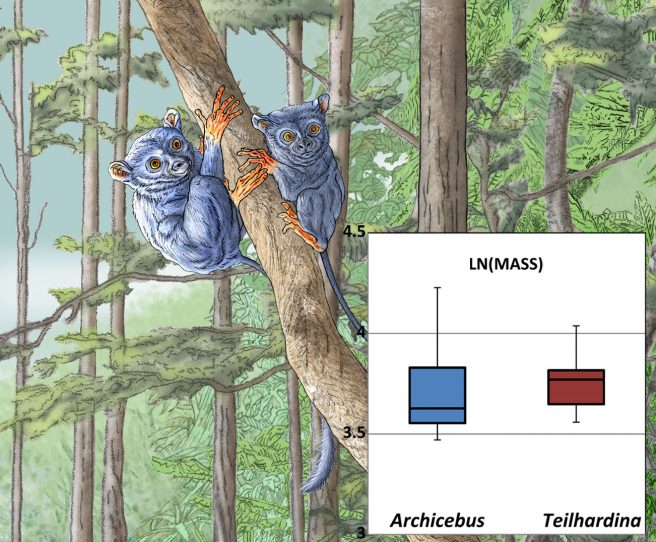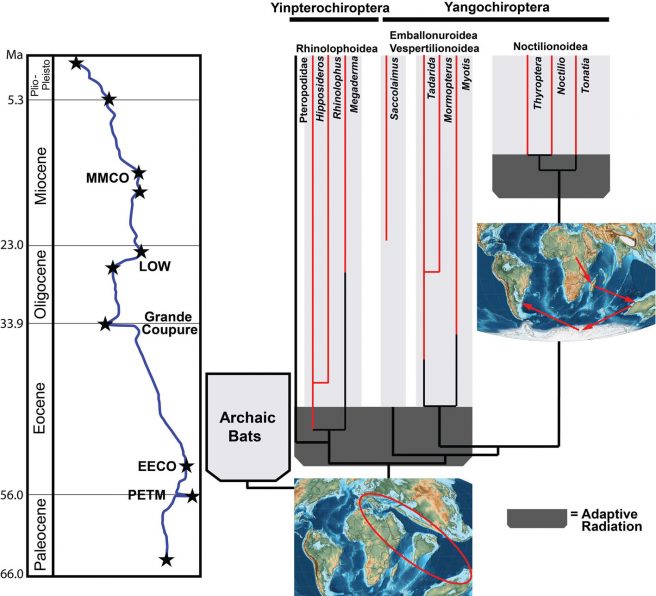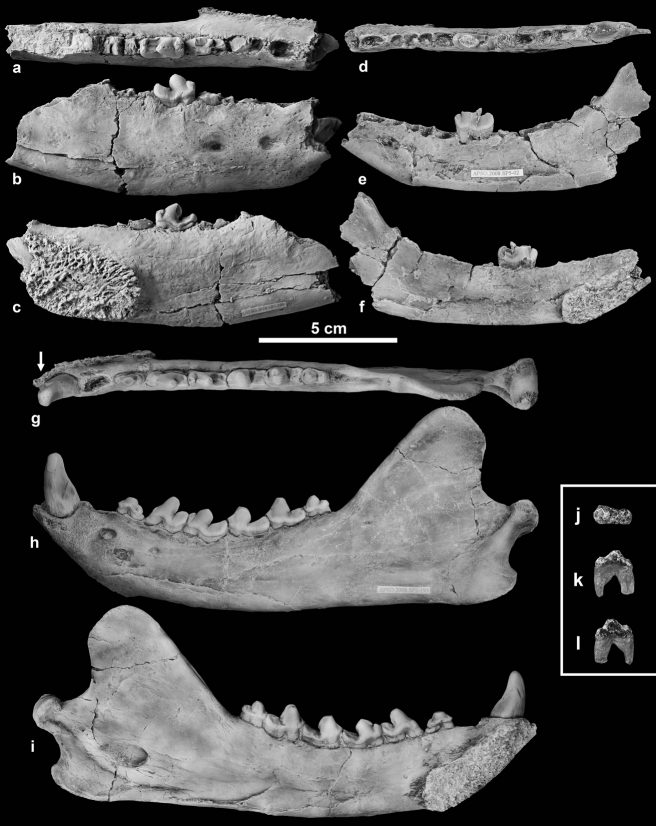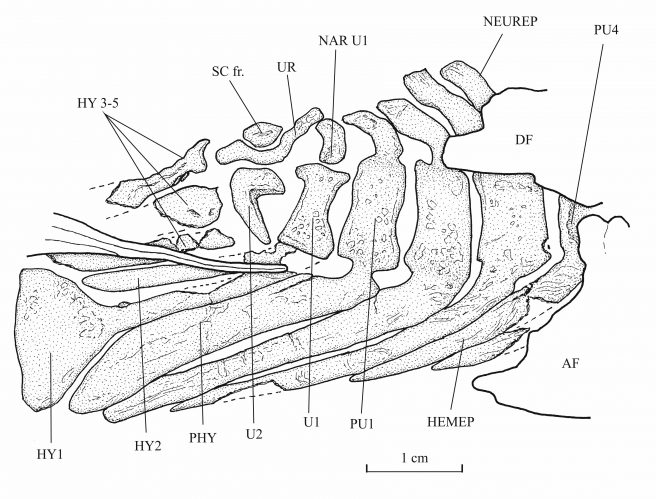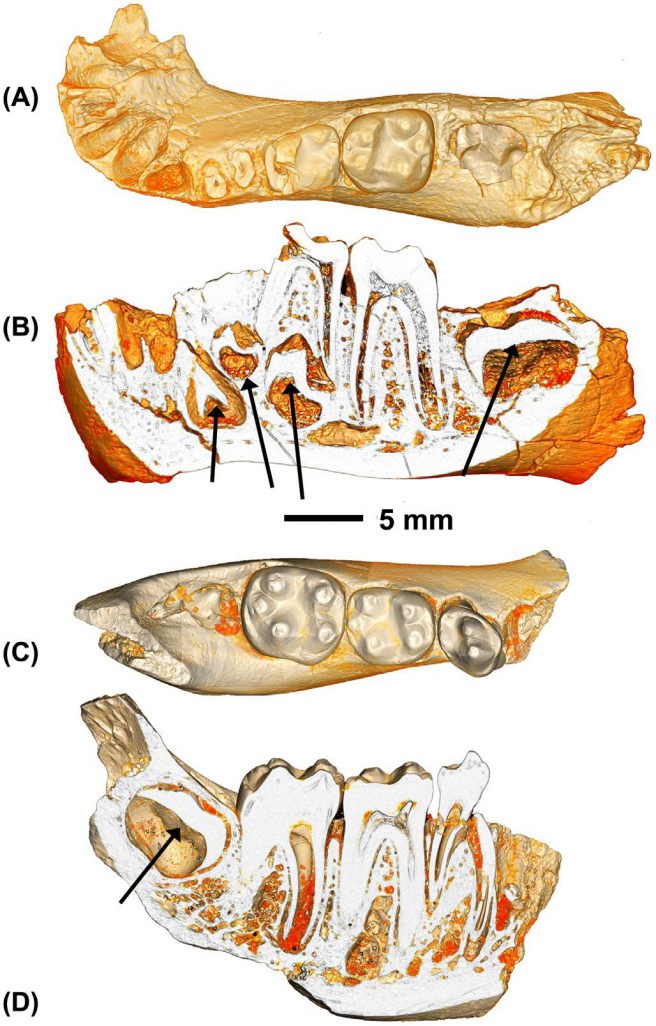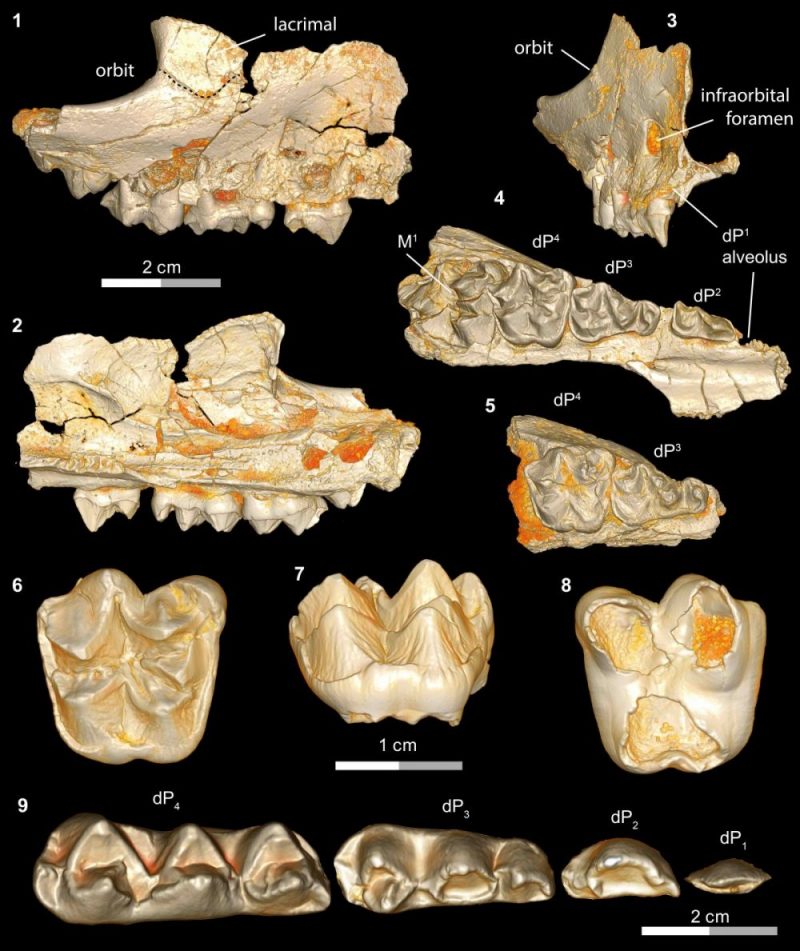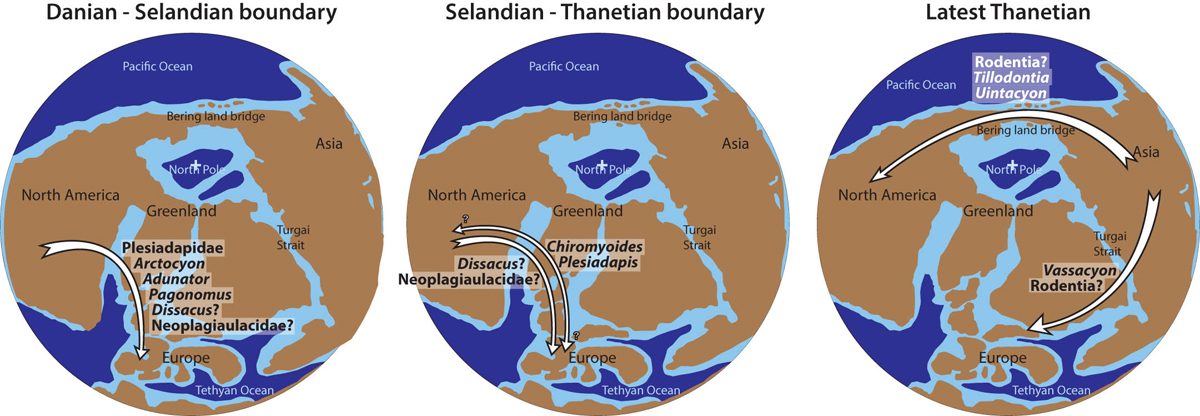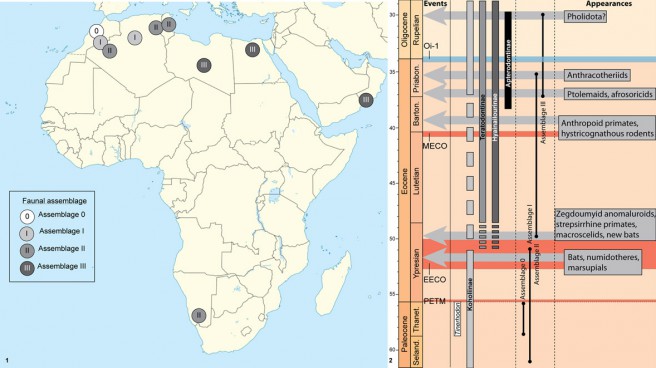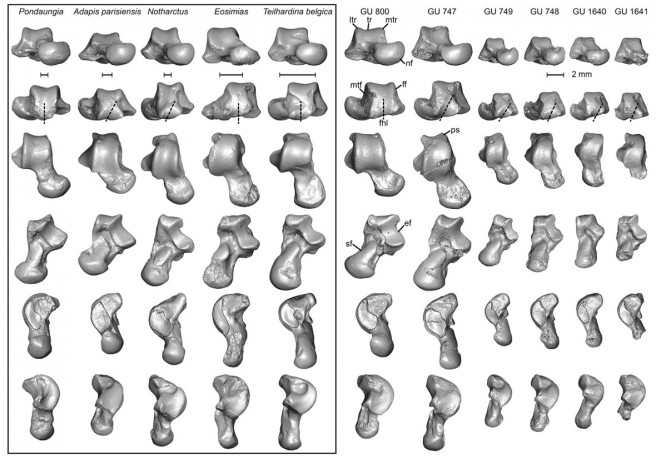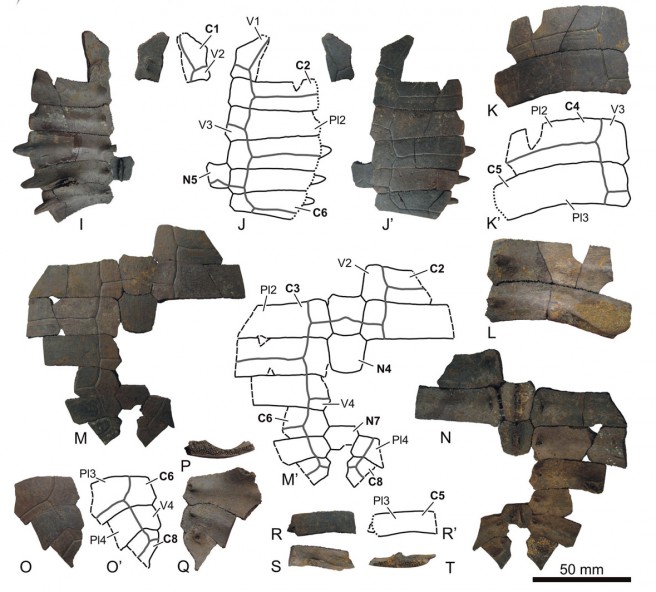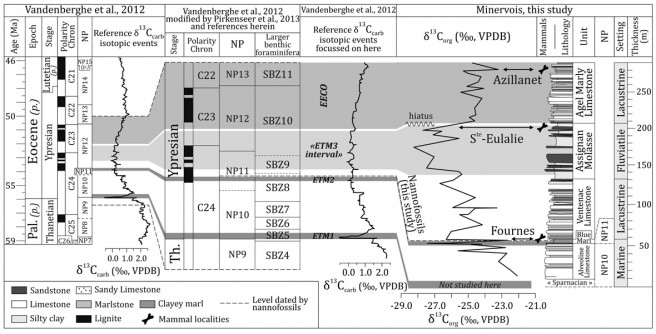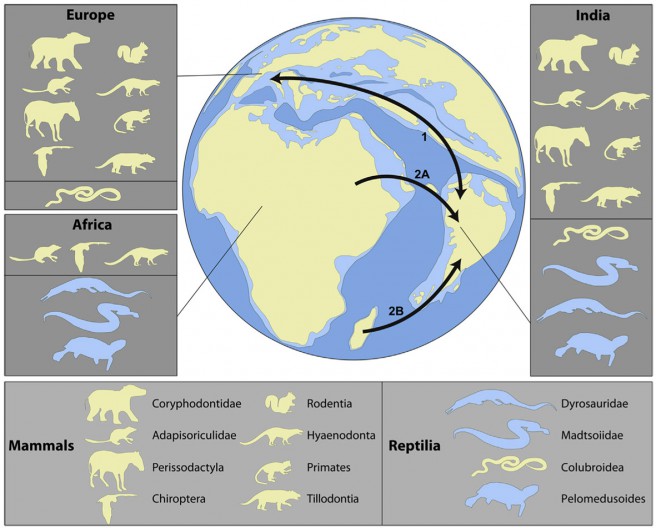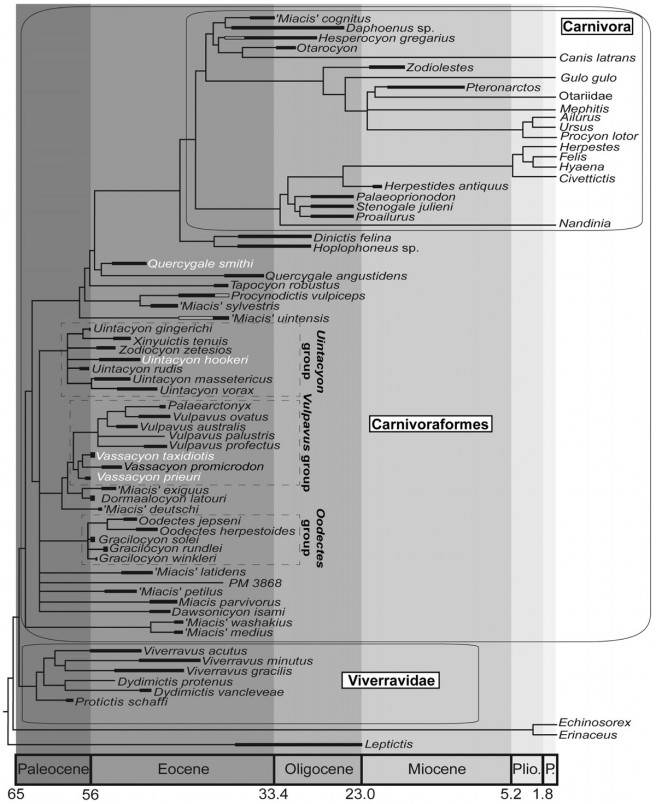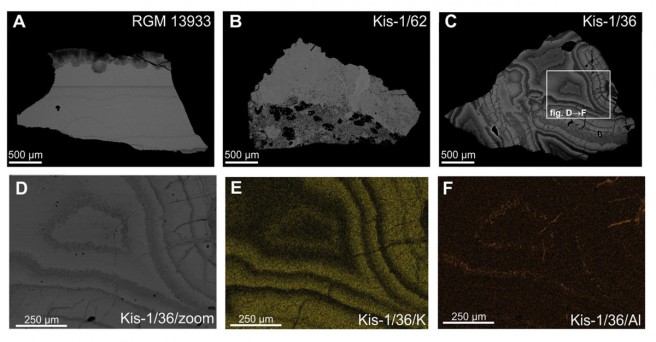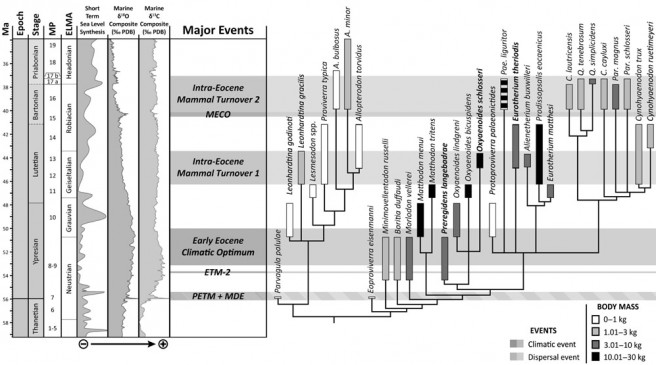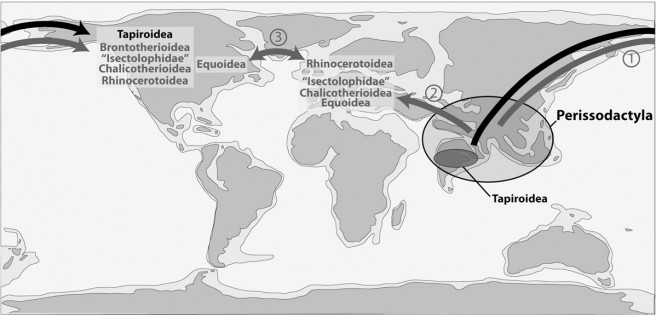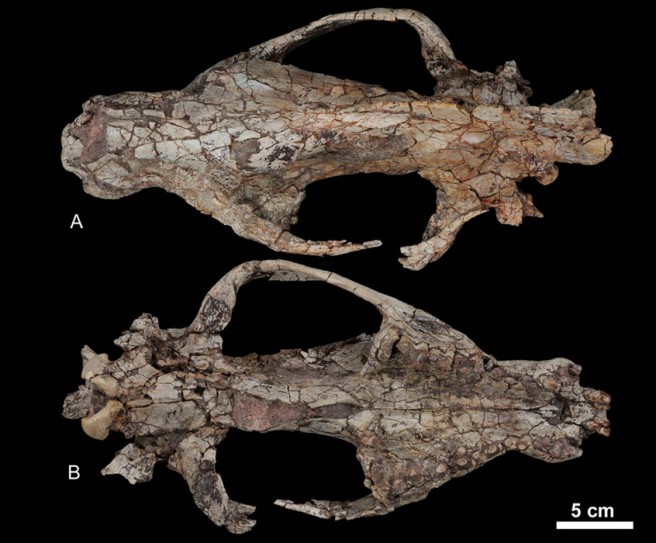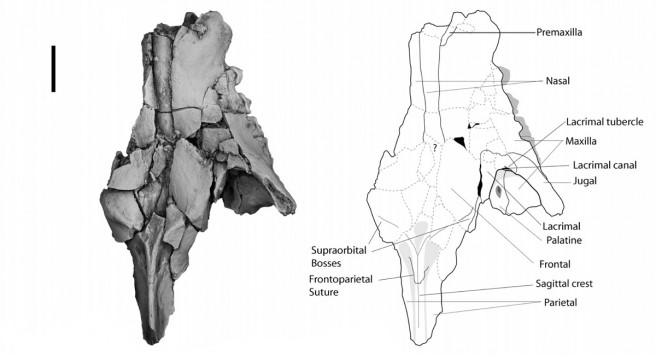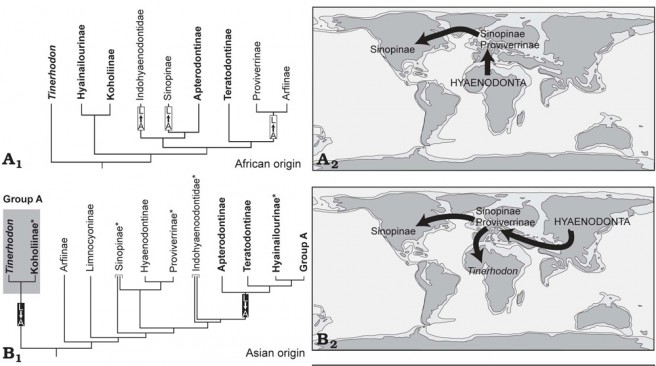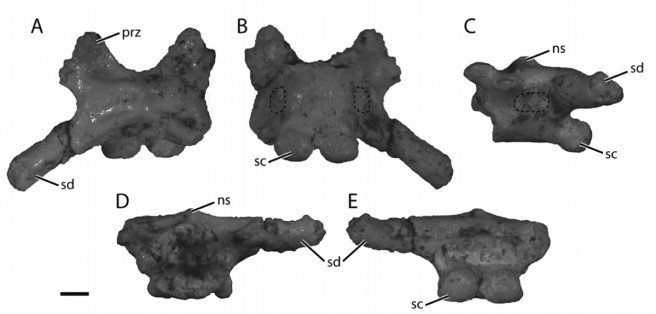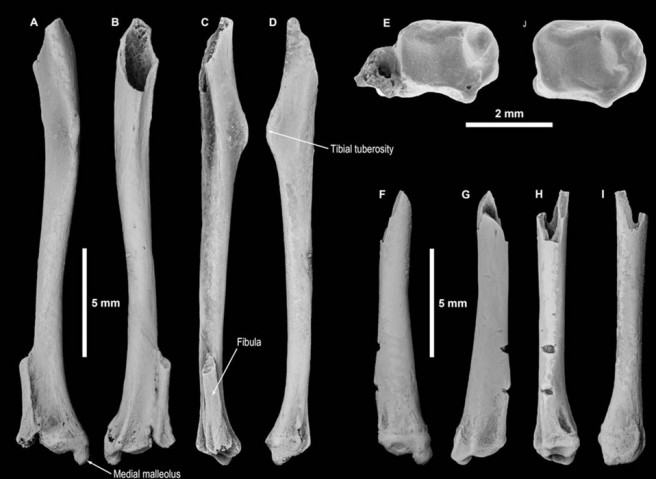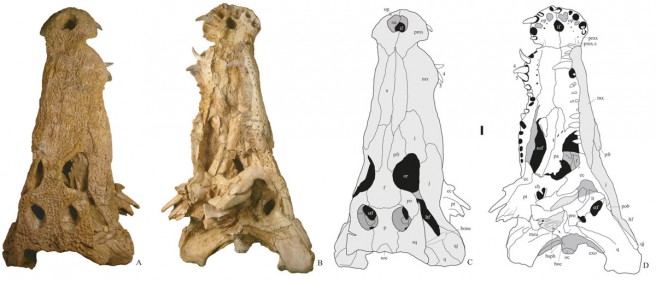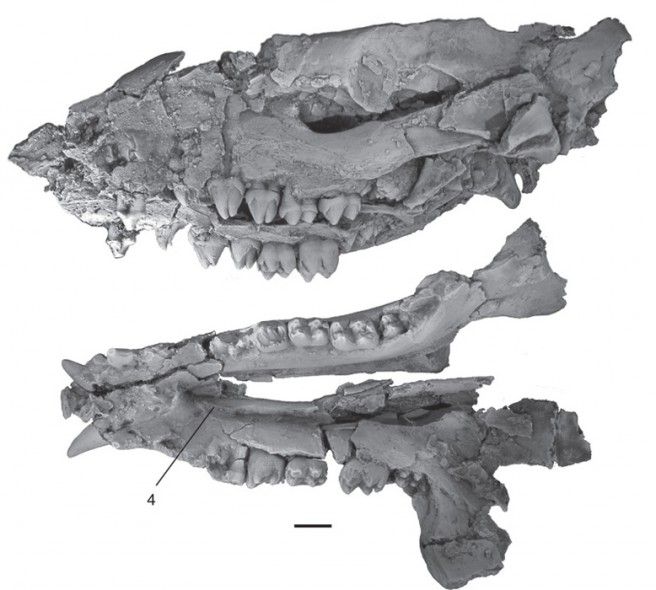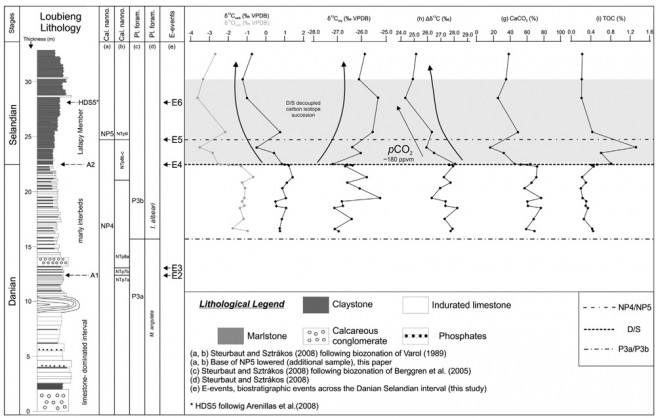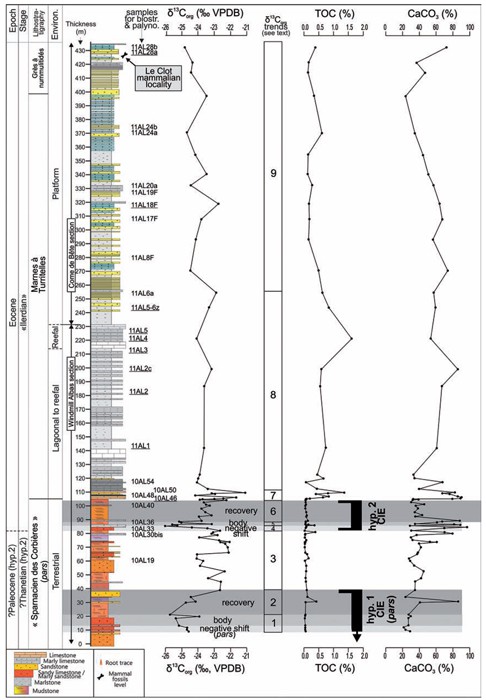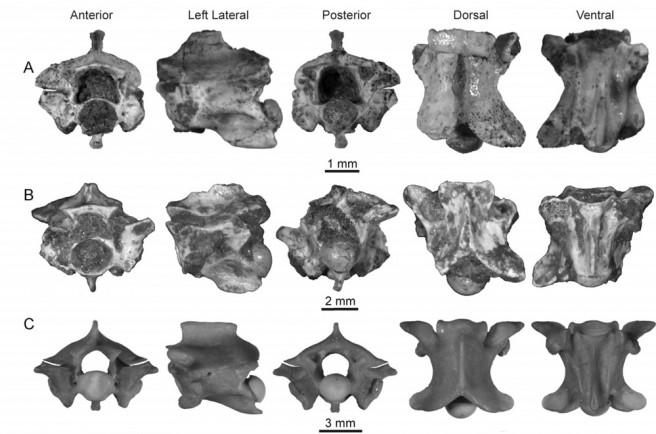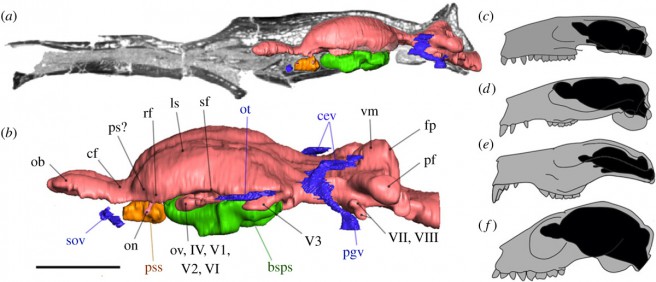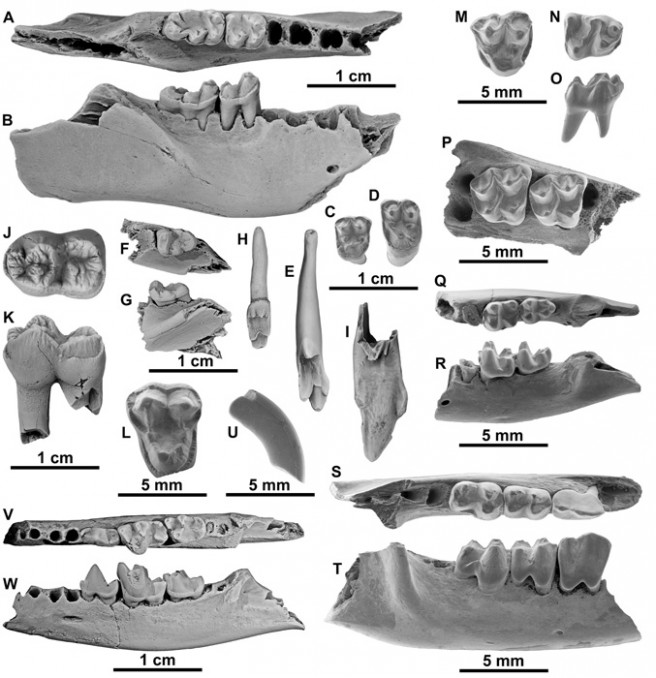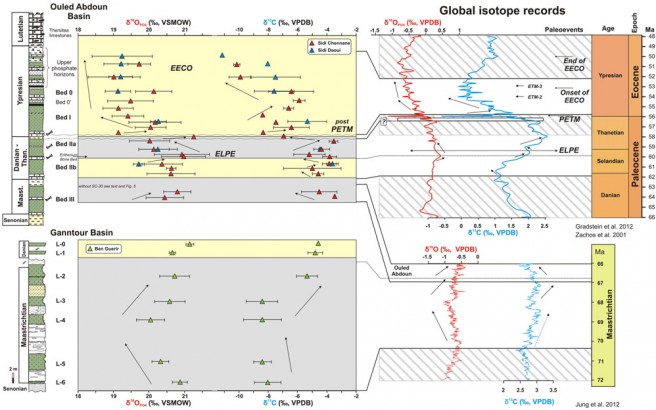|
Posted on April 2021 A reassessment of the Oligocene hyracoids from Malembo, Cabinda, Angola The Oligocene Malembo locality, Cabinda exclave, Angola has yielded a rich vertebrate fauna represented by fragmentary remains. This fossiliferous locality is the only definite occurrence of Oligocene terrestrial mammals in sub-Saharan West Africa. The hyracoids from Malembo have only been very succinctly described and compared thus far, so that their systematic attribution is not consensual among specialists. A revision now allows the identification of three (or four) medium to large-sized species represented by Geniohyus dartevellei, Pachyhyrax cf. crassidentatus, and two undetermined taxa. The species G. dartevellei is revived for the holotype of Palaeochoerus dartevellei Hooijer, 1963; this species is unique to Malembo but appears close to Geniohyus mirus, a species only known from the early Oligocene of the Fayum, Egypt. Other species of Geniohyus and Pachyhyrax crassidentatus are also only known from the early Oligocene of the Fayum. The presence of Geniohyus and Pachyhyrax cf. crassidentatus at Malembo supports thus an early Oligocene age for the fauna. This study was published in Geobios (Tabuce et al., in press). |
|
Posted on April 2021 New specimens of the mesonychid Dissacus praenuntius from the early Eocene of Wyoming and evaluation of body size through the PETM in North America The Mesonychia is a group of archaic carnivorous mammals of uncertain phylogenetic affinities with a Holarctic distribution during the Paleogene. Intensive fossil collecting efforts in the Bighorn Basin, Wyoming, have resulted in recovery of the largest sample and most complete specimens yet known of the mesonychid Dissacus praenuntius from the second biozone of the Wasatchian North American Land Mammal Age (Wa-0). The Wa-0 biozone corresponds to the body of the Paleocene-Eocene Thermal Maximum (PETM), a brief but intense global warming event that occurred ~56 Ma ago that significantly impacted terrestrial mammal faunas, including dwarfing in many mammal lineages. To evaluate the potential response of this lineage to climate change, we compared the PETM sample of D. praenuntius with those recovered from just before the PETM in the last biozone of the Clarkforkian North American Land Mammal Age (Cf-3) and just after the PETM in the Wa-1 biozone. While the sample size is still too small to say with certainty, tooth size (as a proxy for body weight) of D. praenuntius appears to be smaller during the late PETM than during either the pre-PETM Cf-3, or post-PETM Wa-1 biozones, suggesting the possibility of a muted dwarfing response to the PETM. However, the pattern observed for D. praenuntius differs from that of many other PETM mammals, as the shift to smaller body size is less pronounced and may have only occurred in late Wa-0. This study was published in Geobios (Solé et al., in press). |
|
Posted on April 2021 New hyaenodonts (Mammalia) from the late Ypresian locality of Prémontré (France) support a radiation of the hyaenodonts in Europe already at the end of the early Eocene We describe three new hyaenodonts from the late Ypresian locality of Prémontré (Aisne, France; close to MP 10 reference level). The new species – Lesmesodon gunnelli nov. sp., Cynohyaenodon smithae nov. sp., and Eurotherium mapplethorpei nov. sp. – represent the oldest occurrences of these three European genera. Lesmesodon gunnelli is also reported from the locality of Cuis (Marne, France; Ypresian, ≈MP 10). We further present the dentition of two specimens of Lesmesodon edingeri from Messel (Hessia, Germany; type locality of the genus) based on μCT scans. Cynohyaenodon smithae and Lesmesodon gunnelli support the presence of small (300-400 g) hyaenodonts in the late Ypresian of the Paris Basin. Estimation of dental indices indicates that these hyaenodonts had an insectivorous diet. The third species – referred to Eurotherium – may have weighed 4-5 kg and, based on dental indices, likely incorporated more vertebrate prey into its diet. We also performed a phylogenetic analysis in order to test the relationships of these new taxa. These newly discovered species imply that the Proviverra/Allopterodon, Cynohyaenodon, and Eurotherium clades appeared in Europe earlier than previously known (i.e., Lutetian, MP 11). They reinforce the hypothesis that the hyaenodonts radiated during the middle-late Ypresian (MP 8/9-10) in Europe and adapted at that time to diverse ecological niches that they still occupied in the Priabonian (MP 13-14). This study was published in Geobios (Solé et al., in press). |
|
Posted on April 2021 A new basal raoellid artiodactyl (Mammalia) from the middle Eocene Subathu Group of Rajouri District, Jammu and Kashmir, northwest Himalaya, India A new artiodactyl of moderate size, Rajouria gunnelli gen. et sp. nov., is described based on several dentaries, maxillae and isolated teeth from the middle Eocene Subathu Group of the Kalakot area, Rajouri District, Jammu and Kashmir, India. Despite its general resemblance with the family Dichobunidae by the retention of a paraconid on m1-2 and a simple P4 where endocristids do not form an anterior loph, this taxon shares with Raoellidae two unambiguous characters: the presence of a hypoconid on p4, and an asymmetrical P4. The phylogenetic position of the new taxon within the Cetacea / Raoellidae clade is strongly supported by eight seven non ambiguous synapomorphies, among which a cristid obliqua on lower molars anteriorly pointing towards the postectoprotocristid, and a P3 with only two roots. The presence of a new basal raoellid in the middle Eocene Subathu Group sheds new light on the phylogeny and paleobiogeography of raoellid artiodactyls. This study was published in Geobios (Rana et al., in press). |
|
Posted on April 2021 Presence of the large aquatic snake Palaeophis africanus in the middle Eocene marine margin of the Congo Basin, Cabinda, Angola Ten isolated snake vertebrae from Landana and Sassa-Zao, Cabinda Exclave, Angola, present a “primitive” grade morphology with a weak lateral compression and do not belong to Palaeophis aff. typhaeus as originally referred to. They well belong to a single taxon and are here attributed to Palaeophis africanus for which the intracolumnar variation is described and illustrated. This species is Lutetian (middle Eocene) in age and originates from a marine coastal environment confirming again the aquatic capabilities of palaeophiid snakes. It represents the third largest species of Palaeophis with P. colossaeus and P. maghrebianus to which it is closely related in our tentative phylogenetic analysis, indicating that these three taxa could belong to an African clade. This study also contributes to the debate on the existence of primitive and advanced grades among palaeophiid snakes. Palaeophis presents laterally compressed anterior trunk vertebrae that could have been often erroneously considered as representing advanced grade species and potential parataxonomy. This study was published in Geobios (Folie et al., in press). |
|
Posted on April 2021 Systematics and diversity of the giant soft-shelled turtles (Cryptodira, Trionychidae) from the earliest Eocene of Belgium In 1909, the famous paleontologist Louis Dollo identified two putative new species of giant soft-shelled turtles from the lowest Eocene record of Belgium, ‘Trionyx erquelinnensis’ and ‘Trionyx levalensis’, from Erquelinnes and Leval, respectively. However, these proposals did not meet the requirements of The International Code of Zoological Nomenclature, so they were considered as nomina nuda. The information on these specimens or about any other specimen of this lineage of giant turtles from the Belgian record is currently extremely limited. Relatively scarce material from giant trionychids has been described for the lower Eocene record of other European regions. Considering the available information, all the European material has recently been recognized as belonging to the genus Axestemys, which has a North American origin, and possibly attributable to a single species, Axestemys vittata, which currently lacks a diagnosis. Numerous and well-preserved Belgian specimens are deposited in the Royal Belgian Institute of Natural Sciences. In addition to the cited individuals from Erquelinnes and Leval, additional specimens from both localities, as well as others from Orp-le-Grand, are part of this collection. These specimens, found between the decades of 1910 and 1930, have been recently restored, and their study is carried out here. This study was published in Geobios (Pérez-García and Smith, in press). |
|
Posted on April 2021 Additional vertebral material of Thaumastophis (Serpentes: Caenophidia) from the early Eocene of India provides new insights on the early diversification of colubroidean snakes The Ypresian Cambay Shale Formation at Vastan, Mangrol, and Tadkeshwar lignite mines in Gujarat, western India, has yielded a rich vertebrate fauna including madtsoiid, palaeophiid, booid, and colubroidean-like snakes. The latter are particularly abundant, but their systematic affinities are difficult to resolve. Here we describe new specimens of the colubroidean-like snake Thaumastophis missiaeni, including anterior, middle, and posterior trunk vertebrae, as well as caudal vertebrae. The combination of primitive and derived caenophidian and colubroidean vertebral characters confirms Thaumastophis as the earliest known stem-colubriform snake while Procerophis, from the same beds, is more derived and considered to represent a crown-Colubriformes. Additionally, Thaumastophis shares with Renenutet enmerwer from the late Eocene of Egypt a unique combination of vertebral characters that suggests an exchange with North Africa was possible along the southern margin of the Neotethys. We erect the new family Thaumastophiidae for Thaumastophis and Renenutet on the basis of their shared derived vertebral morphology. This study was published in Geobios (Zaher et al., in press). |
|
Posted on April 2021 (U-Th)/He Dating of Supergene Iron (Oxyhydr-)Oxides of the Nefza-Sejnane District (Tunisia): New Insights into Mineralization and Mammalian Biostratigraphy The mining district of Nefza-Sejnane (Tunisia) encloses numerous ores and raw material deposits, all formed in relation with successive Fe-rich fluids of meteoric and/or hydrothermal origins. Here, for the first time in Tunisia, (U-Th)/He ages were obtained on supergene goethite from various localities/deposits of the district highlight direct dating of significant weathering episodes during late Tortonian and late Pleistocene. These weathering events are most likely associated with favorable conditions that combine (i) wet climate displaying sufficient meteoric water/fluid; and (ii) regional exhumation, due to large-scale vertical lithospheric movements enhancing the percolation of fluids. Matched with previous works, these results refine the stratigraphic frame for the polymetallic mineralization and clay deposits in the district, confirming the influence of meteoric fluids circulation during the late Cenozoic. |
|
|
As a consequence of the new (U-Th)/He data, we moreover propose a taxonomic and stratigraphic revision of the well-known mammalian fauna from the Fe-rich Douahria locality, suggesting an early Tortonian age for the fossils, i.e., prior to the first episode of meteoric event in the area. This study was published in Minerals (Yans et al., in press). |
|
|
Posted on April 2021 New Specimens of Frugivastodon (Mammalia: Apatotheria) from the Early Eocene of India Confirm Its Apatemyid Status and Elucidate Dispersal of Apatemyidae We here describe 18 new specimens of the sole apatemyid mammal known outside North America and Europe: Frugivastodon cristatus from the early Eocene Cambay Shale Formation of Vastan Lignite Mine, Gujarat, India. This mammal was previously represented by a single isolated lower molar, which hindered the establishment of its relationships among Apatemyidae. The new fossils show that the Indian apatemyid is unique and represents a new morphotype among this family. |
|
|
It is notably characterized by mesiodistally elongated lower molars with a reduced m3, a small hypocone on the upper molars, and a transversely wider M1 than in other apatemyids. The new data supports the inclusion of the enigmatic Uintan Aethomylos within Apatemyidae. The Indian Frugivastodon and the North American Aethomylos might represent a distinct clade of Apatemyidae that originated around the Paleocene-Eocene boundary. A paleobiogeographic analysis suggests that Frugivastodon dispersed from Europe into India during the early Ypresian. We also review the dispersal events that characterized the history of Apatemyidae. This study was published in Vertebrate Paleobiology and Paleoanthropology Series (Solé et al., in press). |
|
|
Posted on April 2021 Anatomy, Relationships, and Paleobiology of Cambaytherium (Mammalia, Perissodactylamorpha, Anthracobunia) from the lower Eocene of western India The anatomy of Cambaytherium, a primitive, perissodactyl-like mammal from the lower Eocene Cambay Shale Formation of Gujarat, India, is described in detail on the basis of more than 350 specimens that represent almost the entire dentition and the skeleton. Cambaytherium combines plesiomorphic traits typical of archaic ungulates such as phenacodontids with derived traits characteristic of early perissodactyls. Cambaytherium was a subcursorial animal better adapted for running than phenacodontids but less specialized than early perissodactyls. The cheek teeth are bunodont with large upper molar conules, not lophodont as in early perissodactyls; like perissodactyls, however, the lower molars have twinned metaconids and m3 has an extended hypoconulid lobe. |
|
|
A steep wear gradient with heavy wear in the middle of the tooth row suggests an abrasive herbivorous diet. Three species of Cambaytherium are recognized: C. thewissi (∼23 kg), C. gracilis (∼10 kg), and C. marinus (∼99 kg). Body masses were estimated from tooth size and long bone dimensions. Biostratigraphic and isotopic evidence indicates an age of ca. 54.5 Ma for the Cambay Shale vertebrate fauna, the oldest Cenozoic continental vertebrate assemblage from India, near or prior to the initial collision with Asia. Cambaytheriidae (also including Nakusia and Perissobune) and Anthracobunidae are sister taxa, constituting the clade Anthracobunia, which is sister to Perissodactyla. We unite them in a new higher taxon, Perissodactylamorpha. The antiquity and occurrence of Cambaytherium—the most primitive known perissodactylamorph—in India near or before its collision with Asia suggest that Perissodactyla evolved during the Paleocene on the Indian Plate or in peripheral areas of southern or southwestern Asia. This study was published in Journal of Vertebrate Paleontology (Rose et al., 2020). |
|
|
Posted on April 2021 The upper Eocene-Oligocene carnivorous mammals from the Quercy Phosphorites (France) housed in Belgian collections The Quercy Phosphorites Formation in France is world famous for its Eocene to Miocene faunas, especially those from the upper Eocene to lower Oligocene, the richest of all. The latter particularly helped to understand the ‘Grande Coupure’, a dramatic faunal turnover event that occurred in Europe during the Eocene-Oligocene transition. Fossils from the Quercy Phosphorites were excavated from the middle 19th century until the early 20th century in a series of sites and became subsequently dispersed over several research institutions, while often losing the temporal and geographical information in the process. In this contribution, we provide an overview and reassess the taxonomy of these barely known collections housed in three Belgian institutions: the Université de Liège, KU Leuven, and the Royal Belgian Institute of Natural Sciences. We focus our efforts on the carnivorous mammals (Hyaenodonta and Carnivoramorpha) and assess the stratigraphic intervals covered by each collection. |
|
|
These fossils are derived from upper Eocene (Priabonian), lower Oligocene (Rupelian), and upper Oligocene (Chattian) deposits in the Quercy area. The richness of the three collections (e.g., the presence of numerous postcranial elements in the Liège collection), the presence of types and figured specimens in the Leuven collection, and some identified localities in the RBINS collection make these collections of great interest for further studies on systematics and the evolution of mammals around the ‘Grande Coupure’. This study was published in Geologica Belgica (Solé et al., 2021). |
|
|
Posted on April 2021 Skeleton of a new owl from the early Eocene of North America (Aves, Strigiformes) with an accipitrid-like foot morphology We describe a partial skeleton of a large-sized owl from Wasatchian strata of the Willwood Formation (Wyoming, U.S.A.). The holotype of Primoptynx poliotauros, gen. et sp. nov., includes all major postcranial bones and is one of the most substantial Paleogene records of the Strigiformes. The fossil shows that owls exhibited a considerable morphological diversity in the early Eocene of North America and occupied disparate ecological niches. As in the protostrigid taxon Minerva from the late early to early middle Eocene of North America, but unlike in extant owls, the ungual phalanges of the hallux and the second toe of the new species are distinctly larger than those of the other toes. Primoptynx poliotauros gen. et sp. nov., however, does not exhibit the derived tibiotarsus morphology of the Protostrigidae. Even though the new species may well be a stem group representative of protostrigid owls, current data do not allow an unambiguous phylogenetic placement. Concerning the size of the ungual phalanges, the feet of P. poliotauros correspond to those of extant hawks and allies (Accipitridae). We therefore hypothesize that it used its feet to dispatch prey items in a hawk-like manner, whereas extant owls kill prey with their beak. Primoptynx and protostrigid owls were possibly specialized in foraging on prey items that required an accipitrid-like killing strategy, such as larger-sized or more defensive mammals. The extinction of these peculiar owls may have been related to the radiation of accipitrid diurnal birds of prey, which appear to have diversified in the late Eocene and early Oligocene. This study was published in Journal of Vertebrate Paleontology (Mayr et al., 2020). |
|
Posted on March 2020 Supergene manganese ore records 75 Myr-long Campanian to Pleistocene geodynamic evolution and weathering history of the Central African Great Lakes Region – Tectonics drives, climate assists The southeastern part of the Democratic Republic of the Congo locally hosts Proterozoic manganese deposits. The deposits of Kisenge-Kamata are the most significant, but manganese ores are also known to occur at Kasekelesa (former Katanga Province) and Mwene-Ditu (former Kasai Province). For the present study, cryptomelane-rich samples from these two localities were dated, using the 40Ar/39Ar step-heating method with a CO2 laser probe. The ages obtained are within a range of c. 77 Myr to c. 2 Myr. Cryptomelane formation took place at c. 76.4 Ma, c. 59.6 Ma, c. 45 Ma, c. 35 Ma, c. 23.8 Ma, c. 15.4 Ma, and c. 13.3 Ma at Kasekelesa, and it occurred at c. 35 Ma, c. 22.4 Ma, c. 15 Ma, c. 5.5–7.2 Ma, c. 3.6 Ma, and c. 2.1–2.3 Ma at Mwene-Ditu. The Campanian age (c. 76.4 Ma) recorded at Kasekelesa is the oldest 40Ar/39Ar age that has up to now been recorded for Mn ores from Africa. It documents the formation of oxidized ore along a Campanian or older erosion surface, which could be part of the ‘African Erosion Surface’. The complete age record suggests that continent-wide tectonics accounts for most of the recognized supergene ore formation episodes, controlled by vertical lithospheric movements that are ultimately responsible for alternating stages of landscape stability and erosion. Tectonics is thus regarded as the first-order control for secondary ore formation in Central Africa, over the last 80 Myr. Climate is a second-order control, because sufficient water supply is needed for supergene enrichment, whereby climatic conditions are recognized to have been favourable during some relatively cold Late Mesozoic and Paleogene periods, as well as during some humid and warm Neogene stages. This study was published in Gondwana Research (De Putter & Ruffet, 2020). |
|
Posted on March 2020 An enigmatic new ungulate-like mammal from the early Eocene of India We report a new genus and species of herbivorous mammal, Pahelia mysteriosa, from the early Eocene Cambay Shale Formation, Tadkeshwar Lignite Mine, Gujarat, India. The new taxon, approximately the size of a small phenacodontid (e.g. Ectocion parvus), is represented by three mandibular fragments, the most complete of which documents nearly the entire symphysis and mandibular body plus P3–M3. Pahelia has incipiently selenolophodont molars with strong exodaenodonty, absent paraconids, weak but distinct entolophids, and prominent ectostylids. Molar size increases distally, but M3 does not develop a prominent third lobe. Premolars are simple, with prominent protoconids and short talonids but little development of other trigonid cusps. The mandibular symphysis is strongly fused, and there is an enlarged alveolus for an anterior tooth. The combination of features present in the new taxon does not closely match that of any known mammal, but there are some similarities to a diversity of ungulates from Africa, Asia, Europe and North America. Preserved morphology is insufficient to assess the affinities of the new taxon with confidence, but a link to Quettacyonidae, also endemic to the Indian subcontinent, is morphologically and biogeographically plausible. If this scenario is correct, it suggests that P. mysteriosa could be a part of the endemic mammalian fauna of India prior to its initial faunal contact with Asia. This study was published in Papers in Palaeontology (Zack et al, 2019). |
|
Posted on October 2019 Dinoflagellate cyst biostratigraphy and palaeoecology of the early Paleogene Landana reference section, Cabinda Province, Angola Forty-four rock samples from the Landana section, belonging to the historical Dartevelle collection of the Royal Museum for Central Africa (RMCA) at Tervuren, Belgium, were palynologically processed and analysed. Systematic analysis of the samples from the Landana sea cliff locality has revealed 90 dinoflagellate cyst taxa spanning an interval that ranges at least from the middle Paleocene to the late Eocene/early Oligocene. This locality represents the first extensive sub-equatorial African Paleogene dinoflagellate cyst record. Dinoflagellate cyst occurrences were calibrated and evaluated against newly revised foraminiferal ranges. This novel dinoflagellate cyst biostratigraphic record was compared and correlated with contemporaneous records relatively close by in the Gulf of Guinea, as well as with records from more distant locations such as Antarctica, Australia and New Zealand. |
|
|
A preliminary dinoflagellate cyst zonation is here proposed comprising three zones and five unzoned yet otherwise distinct intervals. The lower part of the Landana section records a large portion of the early to middle/late Selandian, which is made apparent by the presence of taxa such as Isabelidinium cingulatum, Isabelidinium? viborgense, and Spinidinium densispinatum. The Thanetian through Lutetian part of the section is more fragmentary and is devoid of any significant marker taxa normally typical for this time interval elsewhere. The upper part of the record is largely devoid of dinoflagellate cysts, with the few dinoflagellate cyst-bearing samples pointing to an Eocene to early Oligocene age. Dinoflagellate cyst assemblages are relatively variable and often largely dominated by a single particular taxon or complex. We record remarkably abundant peridinioid cysts signalling high palaeoproductivity for protracted periods of time, resulting from either heightened terrestrial influence or enhanced upwelling. This study was published in Palynology (Steeman et al, 2019). |
|
|
Posted on October 2019 New Paleocene bird fossils from the North Sea Basin in Belgium and France We describe new avian remains from Paleocene localities of Belgium and France. Four bones from the early to middle Selandian of Maret (Belgium) are among the earliest Cenozoic avian remains known from Europe and include the oldest temporally well constrained European records of the Gastornithidae, as well as tentative records of the palaeognathous Lithornithidae and the Ralloidea. A more comprehensive fossil assemblage from the middle Thanetian of Templeuve (France) contains multiple bones of the Lithornithidae as well as a record of the Pelagornithidae. Specimens from the latest Thanetian of Rivecourt-Petit Pâtis (France) are tentatively assigned to the Ralloidea and Leptosomiformes (cf. Plesiocathartes). Because of the fragmentary nature of the fossils, the taxonomic identity of a number of other specimens remains uncertain. We note, however, that Paleocene avifaunas of Europe and North America appear to have had different compositions and only a few taxa, such as the palaeognathous Lithornithidae, are known from both continents. This suggests that the very similar early Eocene avifaunas of Europe and North America are the result of early Cenozoic dispersal events. This study was published in Geologica Belgica (Mayr & Smith, 2019). |
|
Posted on October 2019 A diverse bird assemblage from the Ypresian of Belgium furthers knowledge of early Eocene avifaunas of the North Sea Basin We describe an assemblage of 54 avian bones from early Eocene marine sediments of the Ampe quarry near Egem in Belgium. The fossils belong to at least 20 species in more than 11 higher-level taxa. Well-identifiable specimens are assigned to the Odontopterygiformes, Galliformes, Messelornithidae, Apodiformes, Halcyornithidae, Leptosomiformes (cf. Plesiocathartes), and Coraciiformes (cf. Septencoracias). Further specimens are tentatively referred to the phaethontiform Prophaethontidae and to the Accipitridae, Masillaraptoridae, and Alcediniformes. The three-dimensionally preserved fossils from Egem provide new data on the osteology of taxa that are otherwise mainly known from compression fossils with crushed bones. The material also includes specimens that further knowledge of the composition of early Eocene avifaunas of the North Sea Basin. The comparatively well-represented small galliform species is clearly distinguished from the early Eocene Gallinuloididae and most closely resembles Argillipes aurorum, a largely ignored galliform species from the London Clay. |
|
|
The tentatively identified fossils of Accipitridae and Alcediniformes would represent the earliest fossil records of these clades. The bird assemblage from Egem includes relatively few seabirds (Odontopterygiformes, cf. Prophaethontidae) and is dominated by remains of terrestrial species (Galliformes, Messelornithidae). Arboreal birds (Halcyornithidae, Leptosomiformes, cf. Alcediniformes, Coraciiformes) are less abundant and aerial insectivores (Apodiformes) very scarce, which either indicates a taphonomic bias in the composition of the avifauna or particular paleoenvironmental characteristics of the nearshore habitats in that area of the southern North Sea Basin. This study was published in Neues Jahrbuch für Geologie und Paläontologie, Abhandlungen (Mayr & Smith, 2019). |
|
|
Posted on March 2019 New paroxyclaenid mammals from the early Eocene of the Paris Basin (France) shed light on the origin and evolution of these endemic European cimolestans We describe four new species of an enigmatic family of mammals, which is endemic to Europe, the Paroxyclaenidae. The fossils described come from six localities of the Ypresian of the Paris Basin (France): Pourcy, Mutigny, Avenay, Condé-en-Brie, Grauves and Prémontré. They allow the description of three new genera and four new species belonging to the subfamilies Merialinae and Paroxyclaeninae. Two of these new species represent the earliest occurrence of each subfamily. Fossils from Mutigny, Avenay and Condé-en-Brie indicate that merialines were more abundant than paroxyclaenines during the Ypresian. Surprisingly, merialines disappeared from the fossil record at the end of the Ypresian – the youngest records are close to the Ypresian/Lutetian boundary – while the paroxyclaenines were present in Europe until the end of the middle Eocene. |
|
|
Based on comparison with the data presently available for European mammals during the Ypresian, we suggest the existence of two periods of faunal turnover that must be more extensively studied in the future in order to be fully characterized: the ‘Intra-Ypresian Mammal Turnover’ and the ‘Ypresian–Lutetian Mammal Turnover’. Finally, because the oldest paroxyclaenids appear morphologically closer to cimolestids such as Procerberus than to pantolestans, it is suggested that similarities between paroxyclaenids and pantolestans could be due to convergence. This study was published in Journal of Systematic Palaeontology (Solé et al, 2019). |
|
|
Posted on February 2019 Cabindachanos dartevellei gen. and sp. nov., a new chanid fish (Ostariophysi, Gonorynchiformes) from the marine Paleocene of Cabinda (Central Africa) The osteology of Cabindachanos dartevellei gen. and sp. nov., a fossil fish from the marine Danian or early Selandian deposits of Landana (Cabinda Territory, Central Africa), is here studied in detail. This fish is known by only one partially preserved specimen that shows typical characters. The opercle is greatly hypertrophied. The preopercle has a very broad dorsal limb and a long narrower ventral limb. There is a wide plate‐like suprapreopercle. The lower jaw is deep, with a well‐marked coronoid process formed by the dentary. The articulation between the quadrate and the |
|
|
The straight angle formed by the two limbs of the preopercle and the well‐developed posterior median crest of the supraoccipital indicate that C. dartevellei belongs to the subfamily Chaninae and the tribe Chanini. This study was published in Geologica Belgica (Taverne et al, 2019). |
|
|
Posted on January 2019 Calcardea junnei Gingerich, 1987 from the late Paleocene of North America is not a heron, but resembles the early Eocene Indian taxon Vastanavis Mayr et al., 2007 We revisit the holotype of Calcardea junnei Gingerich, 1987 from the latest Paleocene (Clarkforkian) of the Willwood Formation (Wyoming, USA). The species is based on a partial skeleton and was originally assigned to the Ardeidae (herons). As we show, this classification cannot be upheld and Calcardea Gingerich, 1987 more closely resembles the taxon Vastanavis Mayr et al., 2007 (Vastanavidae), a parrot-like bird from the early Eocene of India. Even though C. junnei is a large bird, its long wings and short tarsometatarsus argue against a predominantly terrestrial way of living, and the morphology of the tarsometatarsus and pedal phalanges instead suggest strong grasping feet. We conclude that an assignment of Calcardea to the landbird clade (Telluraves) is better supported than its classification into the waterbird clade (Aequornithes), which includes Ardeidae and other ‘ciconiiform’ and ‘pelecaniform’ taxa. Calcardea junnei is one of the oldest known representatives of Telluraves and its morphology shows plesiomorphic features, which contributed to its previous misidentification as a heron. Calcardea exhibits a distinctive osteology and affords a glimpse of a previously unknown late Paleocene avian morphotype. This study was published in Journal of Paleontology (Mayr et al., 2018). |
|
|
Posted on December 2018 New fossils, systematics, and biogeography of the oldest known crown primate Teilhardina from the earliest Eocene of Asia, Europe, and North America Omomyiform primates are among the most basal fossil haplorhines, with the oldest classified in the genus Teilhardina and known contemporaneously from Asia, Europe, and North America during the Paleocene Eocene Thermal Maximum (PETM) 56 million years ago. Characterization of morphology in this genus has been limited by small sample sizes and fragmentary fossils. A new dental sample (n = 163) of the North American species Teilhardina brandti from PETM strata of the Bighorn Basin, Wyoming, documents previously unknown morphology and variation, prompting the need for a systematic revision of the genus. The p4 of T. brandti expresses a range of variation that encompasses that of the recently named, slightly younger North American species ‘Teilhardina gingerichi’, which is here synonymized with T. brandti. A new partial dentary preserving the alveoli for p1-2 demonstrates that T. brandti variably expresses an unreduced, centrally-located p1, and in this regard is similar to that of T. asiatica from China. |
|
|
This observation, coupled with further documentation of variability in p1 alveolar size, position, and presence in the European type species T. belgica, indicates that the original diagnosis of T. asiatica is insufficient at distinguishing this species from either T. belgica or T. brandti. Likewise, the basal omomyiform ‘Archicebus achilles’ requires revision to be distinguished from Teilhardina. Results from a phylogenetic analysis of 1890 characters scored for omomyiforms, adapiforms, and other euarchontan mammals produces a novel clade including T. magnoliana, T. brandti, T. asiatica, and T. belgica to the exclusion of two species previously referred to Teilhardina, which are here classified in a new genus (Bownomomys americanus and Bownomomys crassidens). While hypotheses of relationships and inferred biogeographic patterns among species of Teilhardina could change with the discovery of more complete fossils, the results of these analyses indicate a similar probability that the genus originated in either Asia or North America. This study was published in Journal Human Evolution (Morse et al., 2018). |
|
|
Posted on November 2018 Reassessment of historical sections from the Paleogene marine margin of the Congo Basin reveals an almost complete absence of Danian deposits The early Paleogene is critical for understanding global biodiversity patterns in modern ecosystems. During this interval, Southern Hemisphere continents were largely characterized by isolation and faunal endemism following the breakup of Gondwana (Africa, Antarctica, India, Madagascar, South America, and Australia. Africa has been proposed as an important source area for the origin of several marine vertebrate groups but its Paleogene record is poorly sampled, especially from sub-Saharan Africa. To document the early Paleogene marine ecosystems of Central Africa, we revised the stratigraphic context of sedimentary deposits from three fossil-rich vertebrate localities: the Landana section in the Cabinda exclave (Angola), and the Manzadi and Bololo localities in western Democratic Republic of Congo. We provide more refined age constraints based on invertebrate and vertebrate faunas, foraminiferal and dinoflagellate cyst assemblages, and carbon isotope records. We find an almost complete absence of Danian-aged rocks in the Landana section, contrary to prevailing interpretations over the last half a century. Refining the age of these Paleocene layers is indeed crucial for analyzing fish evolution in a global framework, with implications for the early appearance of Scombridae (tunas and mackerels) and Tetraodontiformes (puffer fishes). The combination of vertebrate fossil records from Manzadi and Landana sections suggests important environmental changes around the Cretaceous/Paleogene transition characterized by an important modification of the ichthyofauna. A dramatic faunal shift is the decrease in overall richness that lasts from the Selandian (middle Paleocene) to the Ypresian (early Eocene). The Lutetian (middle Eocene) of West Central Africa is characterized by the first appearance of numerous cartilaginous and bony fishes. Our analysis of the ichthyofauna moreover indicates two periods of faunal exchanges: one during the Paleocene, where Central Africa appears to have been a source for the European marine fauna, and another during the Eocene when Europe was the source of the Central Africa fauna. These data indicate that Central Africa has had connections with the Tethyian realm. This study was published in Geoscience Frontiers (Solé et al., 2018). |
|
|
Posted on October 2018 Shell anatomy of the African Paleocene bothremydid turtle Taphrosphys congolensis and systematic implications within Taphrosphyini The bothremydid pleurodiran turtle Taphrosphys congolensis is a member of Taphrosphyina from the Paleocene of the Cabinda Province (Congo Basin, Angola). Very few specimens corresponding to elements of its shell have been so far figured. Abundant unpublished remains are analyzed in this paper. As a consequence, several regions of the shell are figured and characterized here for the first time, and intraspecific variability is recognized for several characters. Previous authors proposed some putative differences between the shells of Taphrosphys congolensis and the North American Paleocene Taphrosphys sulcatus. The increase in the knowledge about the shell of this African form allows us to refute most of them, the shell of both forms being recognized as more similar than previously identified. Thus, the identification of the genus Taphrosphys as restricted to three forms (i.e. the skull taxon Taphrosphys ippolitoi, and the skull and shell forms T. congolensis and T. sulcatus) is supported, and the record unquestionably attributable to this genus is modified from the Upper Cretaceous–Eocene lapse of time to the Paleocene exclusively. |
|
|
This study was published in Historical Biology (Pérez García et al., 2018). |
|
|
Posted on October 2018 Mastication and enamel microstructure in Cambaytherium, a perissodactyl like ungulate from the early Eocene of India The dentition of Cambaytherium was investigated in terms of dental wear, tooth replacement and enamel microstructure. The postcanine tooth row shows a significant wear gradient, with flattened premolars and anterior molars at a time when the last molars are only little worn. This wear gradient, which is more intensive in Cambaytherium thewissi than in Cambaytherium gracilis, and the resulting flattened occlusal surfaces, may indicate a preference for a durophagous diet. The tooth replacement (known only in C. thewissi) shows an early eruption of the permanent premolars. They are in function before the third molars are fully erupted. During the dominant phase I of the chewing cycle the jaw movement is very steep, almost orthal, with a slight mesiolingual direction and changes into a horizontal movement during phase II. The enamel microstructure shows Hunter-Schreger-bands (HSB) in the inner zone of the enamel. In some teeth the transverse orientation of the HSB is modified into a zig-zag pattern, possibly an additional indicator of a durophagous diet. |
|
|
This study was published in Paläontologische Zeitschrift (Koenigswald et al., 2018). |
|
|
Posted on October 2018 New fossils from Tadkeshwar Mine (Gujarat, India) increase primate diversity from the early Eocene Cambay Shale Several new fossil specimens from the Cambay Shale Formation at Tadkeshwar Lignite Mine in Gujarat document the presence of two previously unknown early Eocene primate species from India. A new species of Asiadapis is named based on a jaw fragment preserving premolars similar in morphology to those of A. cambayensis but substantially larger. Also described is an exceptionally preserved edentulous dentary (designated cf. Asiadapis, unnamed sp. nov.) that is slightly larger and much more robust than previously known Cambay Shale primates. Its anatomy most closely resembles that of Eocene adapoids, and the dental formula is the same as in A. cambayensis. A femur and calcaneus are tentatively allocated to the same taxon. Although the dentition is unknown, exquisite preservation of the dentary of cf. Asiadapis sp. nov. enables an assessment of masticatory musculature, function, and gape adaptations, as well as comparison with an equally well-preserved dentary of the asiadapid Marcgodinotius indicus, also from Tadkeshwar. The new M. indicus specimen shows significant gape adaptations but was probably capable of only weak bite force, whereas cf. Asiadapis sp. nov. probably used relatively smaller gapes but could generate relatively greater bite forces. This study was published in Journal of Human Evolution (Rose et al., 2018). |
|
|
Posted on July 2018 Plesiadapid mammals from the latest Paleocene of France offer new insights on the evolution of Plesiadapis during the Paleocene-Eocene transition Plesiadapidae are among the most successful mammal families of the Paleocene, but in North America they disappear abruptly around the Paleocene-Eocene boundary. In contrast, in Europe, they survive a few million years into the Eocene, although only as the genus Platychoerops. The latest Paleocene deposits of Petit-Patis (Paris Basin, France) have produced three new plesiadapid species, one of each genus known in Europe: Plesiadapis ploegi, sp. nov., Platychoerops boyeri, sp. nov., and Chiromyoides mauberti, sp. nov. Each of these new species is represented by the very characteristic upper incisor, thus ascertaining their concomitant presence and in particular the spatial and temporal coexistence of Plesiadapis and Platychoerops. Plesiadapis ploegi, sp. nov., is morphologically intermediate between Plesiadapis tricuspidens and Platychoerops russelli, with a tricuspid I1 typical of Plesiadapis and a semimolariform p4 closer to Platychoerops. Its relatively high morphological variability is illustrated. Platychoerops boyeri, sp. nov., has the simple derived I1 of all Platychoerops and a p4 slightly more molariform than that of Ples. ploegi. |
|
|
Chiromyoides mauberti, sp. nov., is closest to Chiromyoides campanicus, but it is smaller and has a particular I1 with multiple posterocones. The systematic position of ‘Platychoerops’ georgei is discussed; this taxon is considered a chimera, and its type I1 belongs to either Chiromyoides or Plesiadapis. Cladistic analysis highlights the paraphyly or polyphyly of all genera of Plesiadapidae. Finally, there is some indication of morphological convergences between European and North American plesiadapids, which may be the result of similar environmental changes on both continents just before the Paleocene-Eocene boundary. This study was published in Journal of Vertebrate Paleontology (De Bast et al., 2018). |
|
|
Posted on July 2018 A Fossil Gekkotan (Squamata) from the Late Oligocene Nsungwe Formation, Rukwa Rift Basin, Tanzania We describe the first record of a fossil gekkotan from the Late Oligocene Nsungwe Formation in the Rukwa Rift Basin, Tanzania. The specimen consists of an almost complete maxilla containing 23 tooth positions, with 10 teeth still in place. Typical gekkotan features include the tall facial process along with a posteriorly sloping angle, and the presence of unicuspid, pleurodont teeth with large resorption pits. Limited preservation does not allow for a more specific systematic assignment, which is why we refer the specimen to Gekkota incertae sedis. The material represents the second record of a Paleogene gekkotan from Africa and the first one from the central part of the continent. This study was published in Journal of Herpetology (Müller et al., 2018). |
|
|
Posted on June 2018 Morphological diversification of ampullariid gastropods (Nsungwe Formation, Late Oligocene, Rukwa Rift Basin, Tanzania) is coincident with onset of East African Rifting A new freshwater gastropod fauna is described from the late Oligocene Nsungwe Formation of the Rukwa Rift Basin, Tanzania. Six new species of ampullariids are established including five species of Lanistes (L. microovum, L. nsungwensis, L. rukwaensis, L. songwellipticus and L. songweovum) and one species of Carnevalea (C. santiapillaii). These taxa occupy a morphospace region comparable to nearly half of extant Lanistes, a common and widespread genus in Africa and Madagascar. Palaeoecological evidence indicates that Nsungwe ampullariids inhabited fluvial, pond and paludal environments. Among these species are the oldest high-spired and fluvially adapated Lanistes taxa. We suggest that Nsungwe Lanistes rapidly diversified in concert with habitat heterogeneity associated with the initiation of rifting along the western branch of the East African Rift System (EARS). Taxonomy, evolution and the biogeographical affinities of Nsungwe Formation freshwater gastropods contributes significantly to expanding the undersampled Palaeogene This study was published in Papers in Palaeontology (Epa et al., 2018). |
|
|
Posted on June 2018 Geology, biostratigraphy and carbon isotope chemostratigraphy of the Palaeogene fossil-bearing Dakhla sections, southwestern Moroccan Sahara New Palaeogene vertebrate localities were recently reported in the southern Dakhla area (southwestern Morocco). The Eocene sediment strata crops out on cliffs along the Atlantic Ocean coast. Vertebrate remains come from five conglomeratic sandstone beds and are principally represented by isolated teeth belonging to micromammals, selachians and bony fishes, a proboscidean assigned to ?Numidotherium sp. and many remains of archaeocete whales (Basilosauridae). From fieldwork five lithostratigraphic sections were described, essentially based on the lithological characteristic of sediments. |
|
|
Despite the lateral variations of facies, correlations between these five sections were possible on the basis of fossil-bearing beds (A1, B1, B2, C1 and C2) and five lithological units were identified. The lower part of the section consists of rhythmically bedded, chert-rich marine siltstones and marls with thin black phosphorite with organic matter at the base. The overlying units include coarse-grained to microconglomeratic sandstones interbedded with silts, indicating deposition in a shallow-marine environment with fluvial influence. The natural remanence magnetization of a total of 50 samples was measured; the intensity of most of the samples is too weak however, before or after the first step of demagnetization. The palaeomagnetic data from the samples are very unstable, except for eight from three similar sandstone levels which show a normal polarity. Matched with biostratigraphic data on rodents, primates, the selachian, sirenian and cetacean faunas, the new carbon isotope chemostratigraphy on organics (1) refines the age of the uppermost C2 fossil-bearing bed to earliest Oligocene time and (2) confirms the Priabonian age of the B1 to C1 levels. This study was published in Geological Magazine (Benammi et al., 2017). |
|
|
Posted on June 2018 The first hyaenodont from the late Oligocene Nsungwe Formation of Tanzania: Paleoecological insights into the Paleogene-Neogene carnivore transition Throughout the Paleogene, most terrestrial carnivore niches in Afro-Arabia were occupied by Hyaenodonta, an extinct lineage of placental mammals. By the end of the Miocene, terrestrial carnivore niches had shifted to members of Carnivora, a clade with Eurasian origins. The transition from a hyaenodont-carnivore fauna to a carnivoran-carnivore fauna coincides with other ecological changes in Afro-Arabia as tectonic conditions in the African Rift System altered climatic conditions and facilitated faunal exchange with Eurasia. Fossil bearing deposits in the Nsungwe Formation in southwestern Tanzania are precisely dated to ~25.2 Ma (late Oligocene), preserving a late Paleogene Afro-Arabian fauna on the brink of environmental transition, including the earliest fossil evidence of the split between Old World monkeys and apes. Here we describe a new hyaenodont from the Nsungwe Formation, Pakakali rukwaensis gen. et sp. nov., a bobcat-sized taxon known from a portion of the maxilla that preserves a deciduous third premolar and alveoli of dP4 and M1. The crown of dP3 bears an elongate parastyle and metastyle and a small, blade-like metacone. Based on alveolar morphology, the two more distal teeth successively increased in size and had relatively large protocones. |
|
|
Using a hyaenodont character-taxon matrix that includes deciduous dental characters, Bayesian phylogenetic methods resolve Pakakali within the clade Hyainailouroidea. A Bayesian biogeographic analysis of phylogenetic results resolve the Pakakali clade as Afro-Arabian in origin, demonstrating that this small carnivorous mammal was part of an endemic Afro-Arabian lineage that persisted into the Miocene. Notably, Pakakali is in the size range of carnivoran forms that arrived and began to diversify in the region by the early Miocene. The description of Pakakali is important for exploring hyaenodont ontogeny and potential influences of Afro-Arabian tectonic events upon mammalian evolution, providing a deep time perspective on the stability of terrestrial carnivore niches through time. This study was published in PLOS ONE (Borths & Stevens, 2017). |
|
|
Posted on May 2018 Incus facet morphology in carnivorous mammals from different ecosystems: Taxonomy vs. habitat This study is prompted by the discovery of an incus of Hyaenodon, the first known auditory ossicle of this genus and thus of any hyaenodont mammal so far. The Hyaenodon incus is small, delicate and possesses an incudo-mallear facet of a general saddle-shape with two articulation facets, a large superior articulation area and a circular, inferior articulation area. Its general morphology and facet shape is most similar to the felid incus morphology. A large set of incus of recent Carnivora (felids, hyaenids, viverrids, herpestids, nandiniid and canids) of different ecosystems has been analysed. This study especially focuses on the incudo-mallear facet. The incudo-mallear facet is composed of: (1) three articular surfaces in felids, (2) a U-shaped surface in hyaenids and (3) four sur-faces in canids. Both taxonomy (on family level) and habitat (open, closed or mixed habitat preference) might have an impact on the morphology of the incus facets, the former having a major impact in our sample. This study was published in Geobios (Bastl, Nagel & Solé, 2017) |
|
|
Posted on May 2018 Evolution of the hypercarnivorous dentition in mammals (Metatheria, Eutheria) and its bearing on the development of tribosphenic molars One major innovation of mammals is the tribosphenic molar, characterized by the evolution of the protocone and the talonid that occlude and provide shearing and crushing functions. This type of molar is an evolutionarily flexible structure that enabled mammals to achieve complex dental adaptations. Among carnivorous mammals, hypercarnivory is a common trend that evolved several times among therians (marsupials, placentals, and stem relatives). Hypercarnivory involves an important simplification of the carnassial molar pattern from the ancestral tribosphenic molar pattern, with the modification of the triangular tooth crown, and the loss of several cusps and cuspids typical of the tribosphenic molar. These losses confer to the molars of the hypercarnivorous mammals a plesiomorphic /paedomorphic morphology that resembles more the earliest mammaliaforms than the earliest therians. Here, we demonstrate that the modification of the molar morphology is fully explained by a patterning cascade mode of cusp development. Contrary to what was previously proposed, our study concludes that the metaconid (mesiolingual cusp of lower molars, associated with a puncturing function) does not influence cusp development of the talonid (distal crushing heel of lower molars). Moreover, it provides a new example of how heterochronic changes were crucial to the evolution of mammal dentition. This study was published in Evolution & Development (Solé & Ladevèze, 2017) |
|
|
Posted on April 2018 A fossil heron from the early Oligocene of Belgium: the earliest temporally well-constrained record of the Ardeidae We describe the earliest temporally well-constrained fossil that can be assigned to the Ardeidae (herons), from the lowermost Oligocene (32.0–33.0 million years ago) of Belgium. The specimen, a partial tarsometatarsus, belongs to a small species and is described as Proardea? deschutteri n. sp. It exhibits the characteristic tarsometatarsus morphology found in extant heron species, but a confident assignment to one of the ardeid subclades is not possible and even the assignment of the new fossil species to the crown group (the clade including the extant species) cannot be established. The fossil indicates a divergence of herons from their sister taxon by at least the earliest Oligocene, and current paleontological data suggest that herons arrived in Europe shortly after a major faunal turnover at the Eocene/Oligocene boundary. We consider that dispersal is the likely reason for the sudden appearance of herons in the earliest Oligocene of Europe but it is uncertain from where exactly this took place, with Asia and Africa being among the candidate areas. This study was published in the journal IBIS (Mayr et al., 2018). |
|
|
Posted on March 2018 First Old World record of the poorly known, swan-sized anseriform bird Paranyroca from the late Oligocene/early Miocene of France A tarsometatarsus of a large anseriform bird from the late Oligocene/early Miocene of the Saint-Gérand-le-Puy area in France is assigned to the distinctive taxon Paranyroca, which was before only known from the early Miocene of North America. Paranyroca may be a stem group representative of Anatidae and its tarsometatarsus exhibits a peculiar character mosaic, with an Anhimidaelike hypotarsus and an Anatidae-like distal end. With regard to these features, the bone resembles the tarsometatarsus of another anseriform bird from Saint-Gérand-le-Puy, which was described as Cygnopterus alphonsi but has not yet been compared with Paranyroca in the original description. C. alphonsi was originally identified as a swan, but this classification has subsequently been contested and here it is proposed that the species is more closely related to Paranyroca. This study was published in Neues Jahrbuch für Geologie und Paläontologie (Mayr & Smith, 2017). |
|
|
Posted on February 2018 A gymnodont fish jaw with remarkable molariform teeth from the early Eocene of Gujarat, India (Teleostei, Tetraodontiformes) The lower jaw of a gymnodont fish collected from the lower Eocene Cambay Shale Formation in Gujarat Province, western India, has fused dentaries without a beak and a remarkable series of teeth that are unique among all known fossil and living Tetraodontiformes. The teeth are molariform, with raised spokes radiating inward from the emarginated peripheral edge of the crown. Tooth development is intraosseous, with new teeth developing in spongy bone before they erupt and attach to the dentary by pedicels. Although many of the 110 tooth loci in the fossil have lost their teeth, in life the teeth would have grown to fit tightly together to form a broad and continuous crushing surface. The estimated age of the Cambay Shale vertebrate fauna is ca. 54.5 Ma, making the jaw the second oldest confirmed gymnodont fossil. Preliminary comparisons with extant taxa of gymnodonts with fused dentaries (e.g., Diodon, Chilomycterus, and Mola) show detailed similarities in jaw structure, but further study of the dentition is needed to better understand the evolutionary position of the new fossil. We describe the new gymnodont as Avitoplectus molaris, gen. et sp. nov., in Avitoplectidae, fam. nov., and place the family as incertae sedis within Gymnodontes. This study is published in Journal of Vertebrate Paleontology (Bemis et al., 2017). |
|
|
Posted on January 2018 Dispersal of the earliest European crocodyloids before the Paleocene-Eocene Thermal Maximum Crocodyloid remains from the late Paleocene of Mont de Berru (France) hosted in the collections of the Muséum National d’Histoire Naturelle (Paris, France) and in the Institut royal des Sciences naturelles de Belgique (Brussels, Belgium) are described for the first time. This material, although fragmentary, can be clearly referred on a morphological basis to Asiatosuchus depressifrons (Blainville, 1855), a species previously reported from several Eocene Belgian localities thanks to abundant material including a nearly complete skeleton. The Paleocene material shares with A. depressifrons the number of alveoli involved in the dentary symphysis, the exclusion of the splenials from the symphysis, and the presence of a distinct depression on the jugal. The fossil remains from Berru represent the oldest European crocodyloid. Along with the alligatoroid Diplocynodon remensis Martin, Smith, de Lapparent de Broin, Escuillié and Delfino, 2014, previously reported from the same locality, the crocodyloid A. depressifrons indicates that these genera reached Europe before the Paleocene-Eocene Thermal Maximum. Although more complete remains from outside Europe are needed to refine phylogenetic hypotheses, according to the currently established fossil record the forerunners of diplocynodontids likely dispersed from North America, whereas those related to Asiatosuchus likely dispersed from Asia. This study was published in Historical Biology (Delfino et al., 2017). |
|
|
Posted on January 2018 A turtle of the African–European Erymnochelys group (Pleurodira, Podocnemididae) in the Belgian fossil record An almost complete plastron, as well as several peripherals and a costal plate of a turtle from the middle Eocene of Saint-Gilles (Brussels), is presented here. Although this turtle specimen was donated to the Institut royal des Sciences naturelles de Belgique (Brussels, Belgium) more than a century ago, it remained undescribed. Its study allows us to recognize the second pleurodiran in the Belgian fossil record, where, until now, the Eocene Neochelys was the only one known. The Belgian material of Neochelys is known in lower Eocene (early Ypresian) levels, but the new pleurodiran specimen comes from the middle Eocene (early Lutetian, NP14 biozone, 46 to 48 Ma). It is the first partial articulate shell of a pleurodiran turtle recognized in Belgium, and the only member of this clade recognized in this country at specific level. The new specimen is a representative of the so-called Erymnochelys group, this lineage being known in Africa from the Upper Cretaceous to the present but in Europe only during the Eocene. It represents the first specimen of Eocenochelus eremberti identified outside its type locality, the French region of Saint-Germain-en-Laye (Yvelines, Île-de-France), where only one specimen was found. The plastron of the Belgian individual corresponds to the most complete for this species. Its analysis allows us not only to broaden the range of paleobiogeographical distribution of Eocenochelus eremberti but also to improve the knowledge about the anatomy and variability of this taxon. This study was published in Fossil Record (Perez-Garcia & Smith, 2017). |
|
|
Posted on June 2017 Estimating body size in early primates: The case of Archicebus and Teilhardina Obtaining accurate estimations of the body mass of fossil primates has always been a subject of interest in paleoanthropology because mass is an important determinant for so many other aspects of biology, ecology, and life history. This paper focuses on the issues involved in attempting to reconstruct the mass of two early Eocene haplorhine primates, Teilhardina and Archicebus, which pose particular problems due to their small size and temporal and phylogenetic distance from extant primates. In addition to a ranking of variables from more to less useful, the effect of using models of varying taxonomic and size compositions is examined. Phylogenetic correction is also applied to the primate database. Our results indicate that the choice of variable is more critical than the choice of model. The more reliable variables are the mediolateral breadth across the femoral condyles and the area of the calcaneocuboid facet of the calcaneus. These variables suggest a body mass of 39 g (range 33-46 g) for Archicebus and 48 g (range 44-56 g) for Teilhardina. The width of the distal femur is found to be the most consistent estimator across models of various composition and techniques. The effect of phylogenetic correction is small but the choice of branch length assumption affects point estimates for the fossils. The majority of variables and models predict the body mass of Archicebus and Teilhardina to be in the range of the smaller extant mouse lemurs, as expected. This research was published in Journal of Human Evolution (Dagosto et al., 2017). |
|
|
Posted on April 2017 33 million year old Myotis (Chiroptera, Vespertilionidae) and the rapid global radiation of modern bats The bat genus Myotis is represented by 120+ living species and 40+ extinct species and is found on every continent except Antarctica. The time of divergence of Myotis has been contentious as has the time and place of origin of its encompassing group the Vespertilionidae, the most diverse (450+ species) and widely distributed extant bat family. Fossil Myotis species are common, especially in Europe, beginning in the Miocene but earlier records are poor. Recent study of new specimens from the Belgian early Oligocene locality of Boutersem reveals the presence of a relatively large vespertilionid. Morphological comparison and phylogenetic analysis confirms that the new, large form can be confidently assigned to the genus Myotis, making this record the earliest known for that taxon and extending the temporal range of this extant genus to over 33 million years. This suggests that previously published molecular divergence dates for crown myotines (Myotis) are too young by at least 7 million years. Additionally, examination of first fossil appearance data of 1,011 extant placental mammal genera indicates that only 13 first occurred in the middle to late Paleogene (48 to 33 million years ago) and of these, six represent bats, including Myotis. Paleogene members of both major suborders of Chiroptera (Yangochiroptera and Yinpterochiroptera) include extant genera indicating early establishment of successful and long-term adaptive strategies as bats underwent an explosive radiation near the beginning of the Early Eocene Climatic Optimum in the Old World. A second bat adaptive radiation in the New World began coincident with the Mid-Miocene Climatic Optimum. This research was published in PLOS ONE (Gunnell et al., 2017). |
|
Posted on March 2017 The evolution of the European mesonychids (Mammal, Mesonychia), and their bearings on the European paleoecosystems and biostratigraphy Mesonychids are an extinct group of primitive hoofed mammals, which possibly have had a scavenger-like diet similar to extant hyenas. Two years ago, the authors started a revision of the fossils of mesonychids that have been found in Europe in order to order their evolution on this landmass. The mesonychids are known from Thanetian and Ypresian localities (from MP6 to MP10 reference-levels). Only the genera Dissacus and Pachyaena were present in this continent. We can describe two new species, respectively from Palette (Ypresian, MP7) – Dissacus rougierae –, and from La Borie and Sézanne-Broyes (Ypresian, MP8+9) – Dissacus raslanloubatieri. The evolution of the geographic distribution of the European mesonychids is characterized by three phases: (1) the mesonychid Dissacus appeared in Europe during the Thanetian (≈ 57-58 Mya), probably due to dispersal from North America; D. europaeus survived the PETM event (≈ 56 Mya) and possibly experienced a dwarfism; (2) the large mesonychid Pachyaena migrated into Europe shortly after the Paleocene-Eocene boundary (≈ 55 Mya), but it was restricted to Northwestern Europe, while Dissacus is recorded at this time only in southwestern Europe (Palette); and (3) Pachyaena rapidly disappeared from European environments, while Dissacus subsequently dispersed into Northwestern Europe (≈ 54-52 Myr ago). Dissacus, which has probably evolved endemically in Europe, reached very large size (close to 60-40 kg), especially in the Southern France and Northern Spain. The long presence in Europe of the mesonychids is possibly due to the few competitors in the European ecosystems. Finally; It seems that the mesonychids went through two radiative events: the first during the Paleocene, the second mostly during the early Eocene. The first one corresponds to the diversification of Dissacus, while the latter resulted in the appearance of the most specialized mesonychids, such as Pachyaena and Mesonyx. This research was published in Journal of Mammalian Evolution (Solé et al., 2017). |
|
Posted on March 2017 New data on the osteoglossid fishes (Teleostei, Osteoglossiformes) from the marine Danian (Paleocene) of Landana (Cabinda Enclave, Angola) A caudal skeleton of a fish from the layer 3 of the marine Danian of Landana (Cabinda Enclave, Angola, Central Africa) is studied in details. Its general characters and its autogenous hypurals show that it is a primitive member of the family Osteoglossidae. The shape and the size of its two ventral hypurals strongly differ from what is known in other Osteoglossidae and even in other Osteoglossomorpha. That justifies the attribution of a peculiar generic status for this fish. Some chronological, stratigraphical and faunal criterions lead to think that it must be reported to the species Ridewoodichthys caheni of which the type material comes from the layers 4 and 5. The caudal skeleton of osteoglossid pattern from the layer 10 of the Danian of Landana previously ranged in R. caheni belongs to a younger and more evolved osteoglossid fish that has not yet received a scientific name. This research was published in Geo-Eco-Trop (Taverne, 2017). |
|
Posted on February 2017 Patterns of dental emergence in early anthropoid primates from the Fayum Depression, Egypt The Fayum Depression of Egypt has produced a remarkable diversity of fossil anthropoids, and this, combined with advances in genetic analyses of living anthropoids, has led to establishment of a temporal and phylogenetic framework for anthropoids that is achieving some degree of consensus. Less well understood are the evolutionary mechanisms and selective factors behind the origin and early diversification of anthropoids. One area that has remained under explored is investigation into the life history patterns of early anthropoids, a major omission given that understanding patterns of growth and development is essential for interpreting the paleobiology of fossil species. Here we detail dental emergence sequences for five species in four families of early anthropoid primates from the Fayum, and use these data to test Schultz’s Rule concerning the timing of emergence of molars versus premolars in mammals. Two important results are generated: (1) only the species Aegyptopithecus zeuxis had a dental eruption sequence identical to that observed among crown catarrhine primates; and (2) in all cases, the permanent canine was the last post-incisor dental element to fully erupt, a finding that may be significant for interpreting early anthropoid behavioral strategies. This research was published in Historical Biology (Miller et al., 2017). |
|
Posted on October 2016 Deciduous dentition and dental eruption sequence of Bothriogenys fraasi (Anthracotheriidae, Artiodactyla) from the Fayum Depression, Egypt Paleogene anthracotheres are poorly documented from Afro-Arabian localities. This is due, in large part, to the fragmentary nature of the specimens that have been described. However, sediments in the Jebel Qatrani Formation, Fayum Depression, Egypt, preserve the richest anthracothere assemblage in all of Afro-Arabia. Unlike other samples, the Fayum collection includes many complete dentitions, skulls, and partial skeletons. Based on these extensive collections, this study provides the first description of the complete deciduous dentition and dental eruption sequence for the early Oligocene anthracothere Bothriogenys fraasi. A detailed discussion concerning the pattern and timing of dental growth in B. fraasi is provided, and the ontogenetic sequence documented for B. fraasi is compared with those available for suoids and hippos, the two extant groups currently considered as possible sister taxa to anthracotheres. Results show that anthracotheres and suoids share a more similar dental emergence pattern, and one that may be close to the primitive condition for artiodactyls, while hippos have a very different dental eruption sequence as a consequence of their highly divergent life history pattern. As a growing body of life history research indicates that taxa in close phylogenetic proximity may be expected to share features of their dental developmental pattern, this finding suggests a useful test of competing hypotheses of a relationship between Anthracotheriidae and either Hippopotamidae or Suiformes can potentially be developed based on eruption patterns. This research was published in Palaeontologia Electronica (Sallam et al., 2016). |
Posted on September 2016
The oldest Cenozoic mammal fauna of Europe: implication of the Hainin reference fauna for mammalian evolution and dispersals during the Palaeocene
The mammal fauna of Hainin is particularly interesting in that it is the oldest of the Cenozoic of Europe. For this reason, it has been chosen as the earliest reference-level (MP1-5) of the mammalian biochronological scale for the European Palaeogene. This paper summarizes the mammal taxa discovered in the fauna, describes four new placental genera and species (Belgoryctes thaleri, Eurolestes dupuisi, Quadratodon sigei, and Cingulodon magioncaldai), and presents an analysis of the fauna as a whole (relative abundance and species richness). The assemblage is relatively small (about 400 dental specimens), characterized by a high diversity and abundance of small insectivorous species and very low abundance of ‘plesiadapiforms’ and ‘condylarths’. By comparison with younger European Palaeocene faunas, ‘condylarths’ and ‘plesiadapiforms’ get more and more abundant and diverse through the Palaeocene but collapse at the Palaeocene-Eocene Boundary. ‘Proteutherians’ decline steadily, while multituberculates remain diverse, although the early Palaeocene is populated mainly by Kogaionidae whereas the late Palaeocene is dominated by Neoplagiaulacidae. The palaeoecology of Hainin is deduced from the mammal assemblage: the local environment was likely a forested area. Stratigraphically, the Hainin deposits are most likely late Danian, and biochronologically its fauna represents a partial equivalent of the North American Torrejonian Land Mammal Age. Finally, when compared to younger Palaeocene faunas of Europe, the composition of the fauna of Hainin reveals that a relatively important intercontinental dispersal of mammals occurred around the Danian-Selandian boundary, roughly corresponding to the Torrejonian-Tiffanian boundary. This dispersal is marked by the arrival in Europe of typically North American taxa such as arctocyonids, plesiadapids and neoplagiaulacid multituberculates. Additional exchanges of lesser magnitude probably also occurred around the Selandian-Thanetian boundary (i.e. during the Tiffanian), although the evidence is less compelling and mainly concern the plesiadapids Chiromyoides and Plesiadapis, and possibly also the mesonychid Dissacus.
|
This research was published in Journal of Systematic Paleontology (De Bast & Smith, 2017). |
|
Posted on September 2016 New fossils of Hyaenodonta (Mammalia) from the Eocene localities of Chambi (Tunisia) and Bir el Ater (Algeria), and the evolution of the earliest African hyaenodonts This study presents the description of new fossils from the Eocene North African localities of Chambi (Tunisia; late Ypresian or early Lutetian) and Bir el Ater (Algeria; latest Bartonian or earliest Priabonian). The specimens from Chambi allow recognizing two recently described hyainailourines: Furodon crocheti and Parvavorodon gheerbranti; these taxa were previously known from the Gour Lazib area (Algeria; late Ypresian or early Lutetian). |
|
|
The new material from Tunisia includes a fragmentary dentary of Parvavorodon that substantially supports the hyainailourine status of this genus and represents the oldest dentary fragment presently known for a juvenile of Hyaenodonta in Africa. The presence of Furodon and Parvavorodon in Chambi strengthens support for the hypothesis of contemporaneity of the Eocene Gour Lazib and Chambi mammal-bearing localities. In addition, the find of a typical teratodontine fourth premolar in Chambi testifies to the presence of a small representative of this group. The fossil record in Bir el Ater is scarcer than in Chambi. However, we recognize specimens attributable to a hyainailourine and a teratodontine. The latter is referred as Masrasector cf. ligabuei, and is the oldest record for this genus. Based on faunal assemblages, we tentatively identify a modification of the hyaenodont fauna in the Maghreb after the “Early Eocene Climatic Optimum” (EECO). This faunal change might be related to the decrease of the global temperature after the EECO event. It appears contemporaneous of a drastic replacement in the composition of the mammal faunas in Africa. Finally, the end of the Eocene (Priabonian) shows an increase in the subfamilial richness amongst hyaenodonts. This study was published in Palaeontologia Electronica (Solé et al., 2016). |
|
|
Posted on August 2016 New euprimate postcrania from the early Eocene of Gujarat, India, and the strepsirrhine-haplorhine divergence The oldest primates of modern aspect (euprimates) appear abruptly on the Holarctic continents during a brief episode of global warming known as the Paleocene-Eocene Thermal Maximum, at the beginning of the Eocene (~56 Ma). When they first appear in the fossil record, they are already divided into two distinct clades, Adapoidea (basal members of Strepsirrhini, which includes extant lemurs, lorises, and bushbabies) and Omomyidae (basal Haplorhini, which comprises living tarsiers, monkeys, and apes). Both groups have recently been discovered in the early Eocene Cambay Shale Formation of Vastan lignite mine, Gujarat, India, where they are known mainly from teeth and jaws Here, we describe new, exquisitely preserved limb bones of these Indian primates that reveal more primitive postcranial characteristics than have been previously documented for either clade, and differences between them are so minor that in many cases we cannot be certain to which group they belong. Nevertheless, the small distinctions observed in some elements foreshadow postcranial traits that distinguish the groups by the middle Eocene, suggesting that the Vastan primates though slightly younger than the oldest known euprimates may represent the most primitive known remnants of the divergence between the two great primate clades. |
|
|
A paper describing these exciting postcranial bones has been published in Journal of Human Evolution (Dunn et al., 2016). |
|
|
Posted on August 2016 Anatomy and variability of Cuvierichelys parisiensis, a geoemydid turtle that crosses the Eocene-Oligocene boundary in Belgium Abundant material of turtles from the early Oligocene site of Boutersem-TGV (Boutersem, Belgium) is presented here. No information on the turtles found there was previously available. All the turtle specimens presented here are attributable to a single freshwater taxon that is identified as a member of Geoemydidae, Cuvierichelys. It is the first representative of the ‘Palaeochelys s. l.–Mauremys’ group recognized in the Belgian Paleogene record. This material, which documents all the elements of both the carapace and the plastron of the taxon, cannot be attributed to the only species of the genus Cuvierichelys so far identified in the Oligocene, the Spanish form Cuvierichelys iberica. Rather, the taxon from Boutersem is recognized as Cuvierichelys parisiensis. Thus, both the paleobiogeographic and the biostratigraphic distributions of Cuvierichelys parisiensis are extended, its presence being confirmed for the first time outside the French Eocene record. The validity of some European forms is refuted, and several characters previously proposed as different between Cuvierichelys iberica and Cuvierichelys parisiensis are recognized as subjected to intraspecific variability. This study was published in Journal of Iberian Geology (Perez-Garcia et al., 2016). |
|
Posted on July 2016 New bio-chemostratigraphic dating of a unique early Eocene sequence from southern Europe results in precise mammalian biochronological tie-points European early Eocene (Ypresian) mammalian biochronology, covering a timespan of about 8 myr, includes three distinct MP (Mammal Paleogene) reference levels MP7, MP8+9 and MP10. These are represented in the unique succession of the Minervois (Southern France) by the localities of Fournes (close to MP7), Sainte-Eulalie (close to MP8+9) and Azillanet (close to MP10). Considering homogenous terrestrial organic matter contribution as suggested by palynofacies and Rock-Eval pyrolysis, we here demonstrate that the organic carbon isotope curve of the predominantly continental Ypresian of the Minervois closely matches the marine standard carbonate carbon isotope curve. |
|
|
The here studied mammalian faunas and their supposed corresponding MP levels can thus be accurately dated and correlated on a global scale. The endemic Fournes mammal fauna, located just above the ETM 2, is assigned to mid-Biochron NP11 Calcareous Nannoplankton Zone. Accordingly, the Fournes mammal site is about 2.5 myr younger than the MP7 reference level of Dormaal (Belgium, latest Biochron NP9), about 1 myr younger than the MP7 mammalian locality of Le Clot in the Corbières (Southern France, late Biochron NP10 or early Biochron NP11) and very close to the Wasatchian Wa-5 mammalian biozone of Wyoming. A mid-Biochron NP12 age is inferred for the endemic Sainte-Eulalie fauna because of its position at the very top of (or just above) the isotopically negative “ETM3 interval”, whereas the Azillanet fauna, recorded at the top of a δ13Ccarborgorg positive trend above the “ETM3 interval”, ranges from late Biochron NP12 to early Biochron NP13. Our results indicate that the shortterm hyperthermals ETM2 and ETM3 did not affect the endemic character of the mammalian faunas in Southern and Northern Europe during the MP7 to MP8+9 interval. The end of this mammalian endemism likely occurred during the early phases of the EECO (Early Eocene Climatic Optimum) in early late Biochron NP12. This analysis was published in Newsletters on Stratigraphy (Noiret et al., 2016). |
|
|
Posted on June 2016 New early Eocene vertebrate assemblage from western India reveals a mixed fauna of European and Gondwana affinities The Ypresian Cambay Shale Formation at Vastan and Mangrol lignite mines in Gujarat, western India, has yielded a rich vertebrate fauna with numerous taxa of European affinities. Here we report a new, approximately contemporary vertebrate assemblage from two fossiliferous layers in the nearby mine of Tadkeshwar. These layers have yielded a similar mammal fauna (perissodactyl-like cambaytheriid Cambaytherium thewissi, the adapoid primates Marcgodinotius indicus, and the hyaenodontid Indohyaenodon raoi). The presence of these species in both Vastan and Tadkeshwar mines and at different levels suggests that the deposits between the two major lignite seams represent a single land mammal age. There is also a new, smaller species of Cambaytherium, and a new genus and species of esthonychid tillodont. This fauna also contains the first large early Eocene vertebrates from India, including an unidentified Coryphodon-like pantodont, a dyrosaurid crocodyliform and a new giant madtsoiid snake. |
|
|
Our results suggest that terrestrial faunas could have dispersed to or from Europe during episodes of contact between the Indian subcontinent and different island blocks along the northern margin of the Neotethys, such as the Kohistane-Ladakh island-arc system. Gondwana taxa might represent remnants of ghost lineages shared with Madagascar, which reached the Indian subcontinent during the late Cretaceous; alternatively they might have come from North Africa and passed along the southern margin of the Neotethys to reach the Indian subcontinent. This research was published in Geoscience Frontiers (Smith et al., 2016). |
|
|
Posted on March 2016 New carnivoraforms from the latest Paleocene of Europe and their bearing on the origin and radiation of Carnivoraformes (Carnivoramorpha, Mammalia) We recently reported the discovery of the earliest European carnivoraforms, based on two new taxa from the latest Paleocene of France and Romania. A new species of Vassacyon, V. prieuri, from the locality of Rivecourt (MP6b; Oise, France) is described based on a dentary fragment and isolated teeth. This species displays several primitive features compared with species of Vassacyon known from the early Eocene of North America and Europe. A second Paleocene carnivoraform, cf. Gracilocyon sp., is described based on fragmentary specimens from the locality of Jibou (MP6b; Transylvania, Romania). Carnivoraformes were previously unknown in Europe before the Eocene, and Vassacyon prieuri and cf. Gracilocyon sp. are their oldest records in Europe. These discoveries favor the hypothesis of a dispersal of these two genera from Europe to North America during the Paleocene-Eocene Thermal Maximum. Vassacyon prieuri and cf. Gracilocyon sp. strengthen support for the level MP6b and its correlation with the Clarkforkian. The geographic origin of the Carnivoraformes remains unknown. However, based on the observed biochronological and geographic distributions of the carnivoraforms, we infer a possible Asian origin for this group. In this scenario, Gracilocyon and Vassacyon dispersed to Europe during the Clarkforkian MP6b time, probably together with rodent taxa, whereas Uintacyon dispersed from Asia to North America shortly after rodents and tillodonts. A paper describing the new specimens and presenting this paleogeographic scenario has been published in the worldwide distributed Journal of Vertebrate Paleontology (Solé et al., 2016). |
|
Posted on December 2015 The age of supergene manganese deposits in Katanga and its implications for the Neogene evolution of the African Great Lakes Region Supergene manganese ores record weathering episodes affecting exposed paleosurfaces; hence, they help identifying and characterizing plateau areas, along the margins of major river basins. Supergene Mn ore deposits commonly contain K-rich Mn oxides with tunnel structure, such as cryptomelane, which are suitable for radiometric dating using the 39Ar–40Ar method. In Africa, Mn deposits have been dated by this method for localities in western and southern parts of the continent, whereas only some preliminary data are available for Central Africa. Extending these initial results, we obtained new 39Ar–40Ar ages for Mn oxide samples of the Kisenge deposit, in southwestern Katanga, Democratic Republic of the Congo. |
|
|
The samples represent supergene Mn oxide deposits that formed at the expense of primary Paleoproterozoic rhodochrosite-dominated carbonate ores. Main phases of Mn oxide formation are dated at c. 10.5 Ma, 3.6 Myr and 2.6 Myr for a core that crosses a mineralized interval. The latter shows a decrease in age with increasing depth, recording downward penetration of a weathering front. Surface samples of the Kisenge deposits also record a ≥c.19.2 Myr phase, as well as c. 15.7 Ma, 14.2 Myr and 13.6 Myr phases. The obtained ages correspond to distinct periods of paleosurface development and stability during the Mio-Pliocene in Katanga. Because Katanga is a key area bordered to the North by the Congo Basin and to the East by the East African Rift System, these ages also provide constraints for the geodynamic evolution of the entire region. For the Mio-Pliocene, the Kisenge deposits record ages that are not systematically found elsewhere in Africa, although the 10.5–11 Myr event corresponds to a roughly simultaneous event in the Kalahari Manganese Field, South Africa.
|
|
|
Posted on October 2015 New fossil of hyaenodonts from the Ypresian and Lutetian of France and the evolution of the Proviverrinae in Europe The Proviverrinae are the most numerous and diversified carnivorous mammals from the Eocene of Europe. This hyaenodont subfamily, which is endemic to Europe, is recorded from the Ypresian of France to the Priabonian of Switzerland. The proviverrines from the Ypresian (MP7–MP10) and Lutetian (MP11–MP14) are represented mainly by species recorded in the northern and central parts of Europe (Paris Basin, Belgian Basin, Germany, Switzerland). In this article, we described fossils from southern France: Saint-Papoul (MP8+9; Aude) and Aigues-Vives 2 (?MP13; Aude). One dentary with secant molars from Saint-Papoul represents a new genus and species, Preregidens langebadrae. |
|
|
One of the three dentaries discovered in Aigues-Vives 2 belongs to the hypercarnivorous Oxyaenoides schlosseri, previously represented by only two isolated lower molars. This dentary appears to be the most derived of the proviverrines. The two other dentaries from Aigues-Vives 2 support the presence of Eurotherium theriodis and provide the first possible evidence of sexual dimorphism in a proviverrine species. A phylogenetic analysis of the proviverrines has been performed to resolve the phylogenetic position of the three taxa. This identifies a close relationship between the new genus (Preregidens) and Oxyaenoides. The new fossils allow the age of Saint-Papoul and Aigues-Vives 2 to be refined: the first locality is considered to be close in age to Avenay (Ypresian; France), while the second one seems to be close to Egerkingen γ (Lutetian; Switzerland), which is considered to be possibly close in age to the MP13 reference level. Finally, the presence of O. schlosseri and E. theriodis in the southern part of France supports the hypothesis that the mammals involved in the first intra-Eocene turnover migrated northwards. This study was published in Palaeontology (Solé et al., 2015). |
|
|
Posted on September 2015 The oldest tapiroid from India and its implication for the paleobiogeographic origin of perissodactyls The presence of cambaytheres, the sister group of perissodactyls, in western India near or before the time of collision with Asia suggests that Perissodactyla may have originated on the Indian Plate during its final drift towards Asia. With this study, we reinforced this hypothesis by reporting two teeth of the first early Eocene tapiromorph Perissodactyla from the Cambay Shale Formation of Vastan Lignite Mine, which we allocate to a new genus and species, Vastanolophus holbrooki. The latter presents plesiomorphic characters typical of the paraphyletic “Isectolophidae,” such as small size and weak lophodonty. However, the weaker hypoconulid and low paralophid, higher cusps, lower cristid obliqua, and the lingual opening of the talonid are found in Helaletidae, the most primitive tapiroid family. |
|
|
Consequently, V. holbrooki may be the oldest and the most primitive tapiroid, suggesting that at least tapiroid perissodactyls originated on India. Its discovery is moreover interesting for reconstructing the early history (i.e. dispersals) of the perissodactyls. This study was published in the specialized journal Palaeovertebrata (Smith et al., 2015). |
|
|
Posted on September 2015 A new large hyainailourine from the Bartonian of Europe the evolution and ecology of massive hyaenodonts The hyainailourines are very large and hypercarnivorous hyaenodonts that originated in Africa. The appearance of this subfamily in Europe is poorly understood but is interesting because it traduces a profound modification of the European ecosystems. In this paper, we presented described a new large-sized species – Kerberos langebadreae – from the Bartonian locality of Montespieu (Tarn, France). The specimens consist of a skull, two hemimandibles and several hind limb elements (fibula, astragalus, calcaneum, metatarsals, and phalanges). Size estimates suggest K. langebadreae may have weighed up to 140 kg, revealing this species as the largest carnivorous mammal in Europe at that time. Moreover, the distinctive skull morphology of the new species reflects a powerful bite force; this hyaenodont was indeed possibly a scavenger. The postcranial elements, which are rarely associated with hyainailourine specimens, indicate an animal capable of a plantigrade stance and adapted for terrestrial locomotion. Based on the first phylogenetic analysis of hyainailourines, we demonstrated that Hemipsalodon, a North American taxon, is a hyainailourine and is closely related to European Paroxyaena. We reconstructed the biogeographic history of the Hyainailourinae: the first migration to Laurasia occurred during the Bartonian that likely included the ancestors of Kerberos, Paroxyaena and Hemipsalodon, which further dispersed into North America at this time. These migrants have no ecological equivalent in Europe and North America during these intervals and likely did not conflict with the endemic hyaenodonts. |
|
|
The discovery of K. langebadreae shows that large body size appears early in the evolution of hyainailourine but the ancestors of these large hyaenodonts are still unknown in Africa, where this subfamily originated. A long paper describing this impressive mammal was published in PLOS ONE (Solé et al., 2015). |
|
|
Posted on July 2015 First cranial and postcranial elements of Indohyaenodon, the oldest hyaenodont from India and their implications for ecology, phylogeny, and biogeography of hyaenodont mammals The reconstruction of the biogeographic history of the earliest hyaenodonts have been importantly affected by the discovery of fossils in the early Eocene of India. We recently reported new remains of the hyaenodont Indohyaenodon raoi from the Vastan Lignite Mine in Gujarat, western India, including the first known rostrum, upper dentition, and postcrania, substantially expanding our knowledge of the species and providing insights into its functional morphology and relationships. Craniodental morphology indeed suggests that I. raoi had a broad diet, including non-vertebrate material as well as flesh of a diversity of prey species. Postcranial morphology is broadly similar to that of other early hyaenodonts and suggests a scansorial locomotor repertoire. |
|
|
Dental morphology indicates that I. raoi is closely related to other South Asian hyaenodonts. We also presented the most comprehensive phylogenetic analysis of Hyaenodonta to date, which corroborates this relationship but finds South Asian hyaenodonts to be the stem of a group that includes most African hyaenodonts. This and other higher-level relationships within Hyaenodonta are, however, weakly supported, and substantially different alternative hypotheses of relationships are not significantly less parsimonious, reflecting strong character conflict. Factors contributing to this conflict include the isolation of hyaenodont faunas on different continents during much of the Eocene, canalization and simplification of carnivorous dentitions, and a lack of non-dental material for critical hyaenodont groups. The new phylogeny is finally consistent with either an African or an Asian origin for the group. This study was published in Journal of Vertebrate Paleontology (Rana et al., 2015). |
|
|
Posted on April 2015 New dental elements of the oldest proviverrine mammal from the early Eocene of Southern France support possible African origin of the subfamily The Paleocene-Eocene Thermal Maximum (PETM), c. 56 Myr ago, is correlated with the first occurrences of modern mammals in Europe (primates, artiodactyls, perissodactyls, carnivoraforms). The carnivorous hyaenodonts are also involved in this faunal event (usually termed Mammal Dispersal Event, MDE). In order to reconstruct the appearance of this group in Europe we studied specimens of hyaenodont mammals from two early Eocene localities of Southern France: Fournes (Minervois) and Fordones (Corbières). Some of these specimens were previously described as cf. Hyracolestes sp. (Cimolesta, Sarcodontidae), a taxon only known from Asia, but new arguments allow their referring to the small proviverrine hyaenodont Parvagula palulae which was previously only recorded in Palette (Provence). |
|
|
This new material shows that, by the beginning of the early Eocene, proviverrines already displayed their typical combination of dental features. The comparison between the earliest European proviverrines and sinopines (a mostly North American radiation) supports the divergence of the two subfamilies by this time – a separation that could have taken place in Europe. Moreover, the early proviverrines are morphologically similar to the African hyaenodont Tinerhodon (late Paleocene). Consequently, we hypothesized that the history of the European proviverrines is likely rooted in Africa. A paper describing the new specimens and presenting these paleogeographic scenarios has been recently published in Acta Palaeontologica Polonica (Solé et al., 2015). |
|
|
Posted on March 2015 The earliest record of the endemic African frog family Ptychadenidae from the Oligocene Nsungwe Formation of Tanzania The Ranoidea is a cosmopolitan radiation of frogs comprising 19 families and more than 2400 extant species (nearly 40% of all anurans). Studies using time-calibrated molecular phylogenies suggest a Cretaceous origin for the Ranoidea, but the Mesozoic and early Cenozoic fossil record of this diverse clade remains poor. Although many fossils have been attributed to the Ranoidea, typically few diagnostic characteristics are provided to assign fossils to specific taxa within the clade. The Ranoidea is thought to have initially diversified in Africa, but the African fossil record of anurans in the Mesozoic and Paleogene is generally poor, with the Afro-Arabian record limited primarily to pipoid frogs or taxonomically enigmatic fossils. |
|
|
These fossils constitute the earliest record of the endemic African ranoid frog family Ptychadenidae from the late Oligocene Nsungwe Formation in the Rukwa Rift Basin of southwestern Tanzania. Paleogene anuran fossils are typically rare, but they constitute approximately 13% of materials collected from localities in the Nsungwe Formation. Radiometrically dated at ≈ 25 Ma, Nsungwe Formation localities preserve a diverse vertebrate fauna and a number of novel invertebrate taxa. Nsungwe Formation anuran fossils include vertebrae preserving a unique sacral morphology that provides the earliest record of the Ptychadenidae, the earliest definitive record of any family within the diverse ranoid clade Natatanura, and the first late Oligocene record of anurans from Africa below the equator. A paper describing this endemic African frog has been published in Journal of Vertebrate Paleontology (Blackburn et al., 2015). |
|
|
Posted on November 2014 New postcranial bones of the earliest Eocene primate Teilhardina belgica Teilhardina belgica is the oldest primate from Europe – it dispersed probably from Asia during the Mammal Dispersal Event. This earliest fossil primate has often been hypothesized as a basal tarsiiform on the basis of its primitive dental formula with four premolars and a simplified molar cusp pattern. Until recently, little was known concerning its postcranial anatomy with the exception of its well-known tarsals. In this paper we describe additional postcranial elements for Teilhardina belgica and compare these to other tarsiiforms and to primitive adapiforms. The forelimb of T. belgica indicates an arboreal primate with prominent forearm musculature, good elbow rotational mobility and a horizontal, rather than a vertical body posture. The lateral hand positions imply grasps adaptive for relatively large diameter supports given its small body size. The hand is long with very long fingers, especially the middle phalanges. The hindlimb indicates foot inversion capabilities, frequent leaping, arboreal quadrupedalism, climbing, and grasping. The long and well-muscled hallux can be coupled with long lateral phalanges to reconstruct a foot with long grasping digits. Our phyletic analysis indicates that we can identify several postcranial characteristics shared in common for stem primates as well as note several derived postcranial characters for Tarsiiformes. |
|
|
This research was published in American Journal of Physical Anthropology (Gebo et al., 2015). |
|
|
Posted on November 2014 New Late Paleocene crocodiliform remains from Berru, France, and the origin of the alligatoroid Diplocynodon The fossil record of the extinct alligatoroid crocodilian Diplocynodon, is very abundant but limited to Europe. However, when and how Diplocynodon dispersed to Europe is still unresolved. Crocodilian remains from the late Palaeocene continental locality of Mont de Berru (Marne, France) offer the opportunity to reassess the taxonomic identity of the oldest diplocynodontid from Europe. Owing to significant morphological differences from previously described species of Diplocynodon, a new species, Diplocynodon remensis, has been erected in this article. |
|
|
Its inclusion in a phylogenetic framework for Eusuchia leads to its positioning as a derived member of diplocynodontids. Diplocynodontidae are viewed as a basal alligatoroid taxon, and, because morphological affinities with the Late Cretaceous−early Eocene North American genus Borealosuchus were mentioned in earlier studies, a comparison amongst D. remensis, Leidyosuchus, and Borealosuchus is presented. Although D. remensis is the geologically oldest diplocynodontid, according to our results, it is not the phylogenetically most primitive. Other morphological discrepancies are highlighted, indicating that the topology recovered here is only tentative. From a biogeographical point of view, the appearance of Diplocynodon in Europe prior to the Palaeocene/Eocene boundary indicates that it did not disperse with North American taxa that reached Europe around the time of the PETM. Therefore, a pre-PETM dispersal from North America at the same times as other vertebrates with clear North American affinities also occurring in the Palaeocene of Europe cannot be excluded. A manuscript detailing this study has been published in Zoological Journal of the Linnean Society (Martins et al., 2014). |
|
|
Posted on November 2014 New fossils suggest the mammalian order Perissodactyla originated in India Perissodactyla is an order of ungulate mammals that includes the extant hippomorphs (equoids) and ceratomorphs (tapiroids and rhinocerotoids) and their extinct relatives, and other extinct groups (chalicotherioids, “isectolophids,” and brontotherioids). It was during the PETM, that perissodactyls first appeared across the Laurasian continents. Since perissodactyls appeared almost simultaneously in Europe, Asia and North America, the place of their origin has long been disputed and numerous authors have tentatively reconstructed the biogeographic history of the earliest perissodactyls from North America, Central America, Africa, India, or Asia. Cambaytheres are recently discovered early Eocene placental mammals from the Indo–Pakistan region. They have been assigned to either Perissodactyla (the clade including horses, tapirs and rhinos, which is a member of the superorder Laurasiatheria) or Anthracobunidae, an obscure family that has been variously considered artiodactyls or perissodactyls, but most recently placed at the base of Proboscidea or of Tethytheria (superorder Afrotheria). We reported new dental, cranial and postcranial fossils of Cambaytherium, from the Cambay Shale Formation, Gujarat, India (c. 54.5 Myr ago). These fossils demonstrate that cambaytheres occupy a pivotal position as the sister taxon of Perissodactyla, thereby providing insight on the phylogenetic and biogeographic origin of Perissodactyla. The presence of the sister group of perissodactyls in western India near or before the time of collision suggests that Perissodactyla may have originated on the Indian Plate during its final drift toward Asia. |
|
|
This discovery was published in Nature Communications (Rose et al., 2014) and well covered by the international press. |
|
|
Posted on September 2014 Reference carbon isotopes on organics of the Late Danian/Early Selandian, to provide isotopic framework for chemostratigraphic correlations. The Global Boundary Stratotype Section and Point for the base of the Selandian Stage is defined in the Zumaia section (Spain) at an abrupt change in lithology (base of Itzurun Formation), which coincides with the onset of a negative carbonate carbon isotope shift. However, this lithological change is not always very well expressed in other sections. In order to document the stratigraphic position of the Danian/Selandian boundary (DSB) on a more global scale, we have investigated three sections across the DSB, the Zumaia reference section (GSSP), the Loubieng section (auxiliary DSB reference section, France) and the Sidi Nasseur section (Tunisia). The Danian/Selandian boundary interval is subdivided and correlated throughout low latitudes, from the Altlantic Bay of Biscay to the Southern Tethys, on the basis of seven calcareous nannofossil and planktonic foraminiferal events (E-events). |
|
|
The base of the Selandian is proved to coincide with the end of the Braarudosphaera acme, which correlates with the lowest consistent occurrence (LCsO) of Lithoptychius aff. bitectus (=Fasciculithus janii sensu Steurbaut and Sztrákos, 2008) (event E4), but which is slightly posterior to the second radiation of the fasciculiths, up to now considered to represent the primary correlation tool of the DSB. A short-term 13Corg negative excursion, associated with an increase in pCO2 is recorded at the very base of the Selandian. It is interpreted as a short period of global warming (hyperthermal), the duration of which is estimated at ~30 kyr. It is followed in all the three studied sections by a long-term decoupled carbon isotope event, marked by increasing 13Corg and decreasing 13Ccarb values. It may reflect a period of climatic cooling of a few 100 kyr, interpreted as a possible precursor of the global cooling event, marking the late Paleocene in the North Atlantic realm. This study was published in Palaeogeography, Palaeoclimatology, Palaeoecology (Storme et al., 2014). |
|
|
Posted on April 2014 Refined dating of the European early placental mammals in the Corbières area, located between reference localities of Northern Europe and Africa. Utilizing bio- and chemostratigraphy, we published an integrated dating of the upper part of the continental “Sparnacien des Corbières” and the overlying marine “lower-middle Ilerdian” succession of Albas-Le Clot (Corbières, France), in order to refine the position and age of the Le Clot mammalian locality. Our data show that this locality, which has yielded a mammal fauna early Ypresian in age (close to MP7, Mammal Paleogene level), is located above the end of the carbon isotope excursion (CIE) the base of which defines the Paleocene-Eocene boundary. The Le Clot mammalian locality is therefore younger than the Paleocene-Eocene Thermal Maximum (PETM), and also younger than the Dormaal MP7 reference fauna in Belgium, which is correlated with the onset of the CIE (nannoplankton Zone NP9b). Moreover, we demonstrate that the Le Clot mammalian locality is older than the Eocene Thermal Maximum 2 (ETM2) event, located in the lower part of NP11 Zone. Associated with the ages of benthic foraminifera and dinocysts observed in the succession, our 13Corg chemostratigraphy suggests that the Le Clot locality is correlated to the upper NP10–lower NP11 Zones. The refined location of the CIE in the Albas-Le Clot section is discussed because two carbon isotope excursions are potentially recorded in the upper “Sparnacien des Corbières”, here recognized as mainly Thanetian in age. A paper describing these results has been published in Newsletters on Stratigraphy (Yans et al., 2014). |
|
Posted on March 2014 Earliest Colubroid-Dominated Snake Fauna from Africa The extant snake fauna has its roots in faunal upheaval occurring across the Paleogene – Neogene transition. On northern continents, this turnover is well established by the late early Miocene. However, this transition is poorly documented on southern landmasses, particularly on continental Africa, where no late Paleogene terrestrial snake assemblages are documented south of the equator. Here we describe a newly discovered snake fauna from the Late Oligocene Nsungwe Formation in the Rukwa Rift Basin of Tanzania. The fauna is small but diverse with eight identifiable morphotypes, comprised of three booids and five colubroids. This fauna includes Rukwanyoka holmani gen. et sp. nov., the oldest boid known from mainland Africa. It also provides the oldest fossil evidence for the African colubroid clade Elapidae. Colubroids dominate the fauna, comprising more than 75% of the recovered material. This is likely tied to local aridification and/or seasonality and mirrors the pattern of overturn in later snake faunas inhabiting the emerging grassland environments of Europe and North America. |
|
|
The early emergence of colubroid dominance in the Rukwa Rift Basin relative to northern continents suggests that the pattern of overturn that resulted in extant faunas happened in a more complex fashion on continental Africa than was previously realized, with African colubroids becoming at least locally important in the late Paleogene, either ahead of or as a consequence of the invasion of colubrids. The early occurrence of elapid snakes in the latest Oligocene of Africa suggests the clade rapidly spread from Asia to Africa, or arose in Africa, before invading Europe. A paper describing these snakes has been published in PLOS ONE (McCartney et al., 2014). |
|
|
Posted on February 2014 Endocranial morphology of Paleocene Plesiadapis tricuspidens and evolution of the early primate brain Expansion of the brain is a key feature of primate evolution. The fossil record, although incomplete, allows a partial reconstruction of changes in primate brain size and morphology through time. Palaeogene plesiadapoids, closest relatives of Euprimates (or crown-group primates), are crucial for understanding early evolution of the primate brain. However, brain morphology of this group remains poorly documented, and major questions remain regarding the initial phase of euprimate brain evolution. Micro-CT investigation of the endocranial morphology of Plesiadapis tricuspidens from the Late Paleocene of Europe, the most complete plesiadapoid cranium known, shows that plesiadapoids retained a very small and simple brain. |
|
|
Plesiadapis has midbrain exposure, and minimal encephalization and neocorticalization, making it comparable with that of stem rodents and lagomorphs. However, Plesiadapis shares a domed neocortex and downwardly shifted olfactory-bulb axis with Euprimates. If accepted phylogenetic relationships are correct, then this implies that the euprimate brain underwent drastic reorganization during the Palaeocene, and some changes in brain structure preceded brain size increase and neocortex expansion during evolution of the primate brain. These important results have been published in Proceedings of the Royal Society B, London (Orliac et al., 2015). |
|
|
Posted on January 2014 First Clarkforkian Equivalent Land Mammal Age in the Latest Paleocene Basal Sparnacian Facies of Europe: Fauna, Flora, Paleoenvironment and (Bio)stratigraphy The Paleocene-Eocene Thermal Maximum (PETM) is correlated with the first occurrences of earliest modern mammals in the Northern Hemisphere. The latest Paleocene Clarkforkian North American Land Mammal Age, that has yielded rodents and carnivorans, is the only exception to this rule. However, until now no pre-PETM localities have yielded modern mammals in Europe or Asia. The new terrestrial vertebrate and macroflora assemblages found at Rivecourt, in the north-central part of the Paris Basin, were analyzed through a multidisciplinary study including sedimentologic, stratigraphic, isotopic, and palynological aspects in order to reconstruct the paleoenvironment and to evaluate biochronologic and paleogeographic implications. The mammals are moderately diverse and not abundant, contrary to turtles and champsosaurs. The macroflora is exceptional in preservation and diversity with numerous angiosperms represented by flowers, fruits, seeds and wood preserved as lignite material, revealing an abundance of Arecaceae, Betulaceae, Icacinaceae, Menispermaceae, Vitaceae and probably Cornaceae. Results indicate a Late Paleocene age based on Carbon isotope data, palynology and vertebrate occurrences such as the choristoderan Champsosaurus, the arctocyonid Arctocyon, and the plesiadapid Plesiadapis tricuspidens. However, several mammal species compare better with the earliest Eocene. Among these, the particular louisinid Teilhardimys musculus suggests a younger age than the typical MP6 reference level. Nevertheless, the most important aspect of the Rivecourt fauna is the presence of dental remains of a rodent and a “miacid” carnivoran, attesting to the presence of two modern mammalian orders in the latest Paleocene of Europe. Therefore, Rivecourt represent the first Clarkforkian equivalent Land Mammal Age in Europe. |
|
|
A long paper describing this new locality was published in PLOS ONE (Smith et al., 2014). |
|
|
Posted on November 2013 Refined dating of the early placental mammals in Morocco, using carbon isotopes on various materials Fossil biogenic apatites were studied for their geochemical composition across the late Cretaceous–early Eocene Moroccan phosphate series in the Ouled Abdoun and Ganntour basins in Morocco in order to characterize paleoenvironmental conditions and to improve stratigraphy. The vertebrate remains show particularly good structural, mineralogical and chemical preservations, which relate to the favorable depositional environment of the phosphorite. The main studied fossils show large range in 13Ccarborg values from−14 to +6‰, which can be coupled to different carbon sources. Enameloid yielded mostly positive 13C isotopic compositions that are comparable with values reported from modern teeth. Coprolites have the lowest 13C values that reflect burial conditions with intensive organic matter recycling. The large variation in 18OPO4 values of the shark teeth can be related to ecological differences. However, the mean 18OPO4 data reflect important temporal variation along the series, together with the corresponding average 13C values. |
|
|
Comparisons with the global isotope records allow identifying the Early Eocene Climatic Optimum in the top of the Ouled Abdoun series (above Bed 0). The isotope data further suggest a sedimentary gap during the latest Thanetian and the Paleocene Eocene Thermal Maximum. The top of the Paleocene series (Bed IIa) can be dated to late Selandian–early Thanetian, with the recognition of the Early Late Paleocene Event (ELPE). The Eritherium Bone Bed, that yielded the earliest known placental mammals from Africa, would be located below the ELPE and therefore, cannot be younger than late Selandian. The isotope data from the older Paleocene (Bed IIb) and Cretaceous (upper Bed III) beds in the Ouled Abdoun Basin can be correlated with the latest Danian – early Selandian and the latest Maastrichtian global isotope record, respectively. Based on the 18OPO4 data, the Cretaceous layers of the Ganntour Basin cover most of the Maastrichtian period except the very early part. A paper describing these results has been published in Palaeogeography, Palaeoclimatology, Palaeoecology (Kocsis et al., 2014). |
|

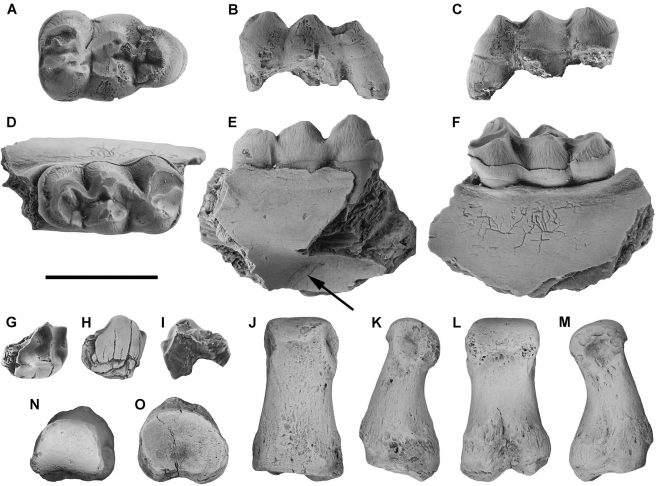
![Sizes [ln (L × W) in millimeters] of lower premolars and molars of North American <em>Dissacus</em> species from the Torrejonian, middle Paleocene, through Wasatchian, early Eocene, strata. The range of variation expected in each sample is 0.40 units on a natural-log (ln) scale (mean ± two standard deviations, where s = 0.10; e.g., Gingerich, 1989, p. 25; Gingerich, 2019). Abbreviations: Cf = Clarkforkian; m = meter level in the Cabin Fork master section; PB = Polecat Bench; Ti = Tiffanian; To = Torrejonian; Wa = Wasatchian.](https://www.paleurafrica.be/wp-content/uploads/2021/04/Dissacus-656x784.jpg)
